
Whats HOT
Latest Posts

Do Press Releases Still Work?
A few years ago I was at a marketing seminar when the discussion turned to whether press releases are still useful. Most of the attendees shook their heads no, and a few vocalized their scorn with comments like “are you kidding?”
Well, I’ve got news for you (pun intended). As a trained journalist who still appreciates receiving press releases, and as a marketing specialist who writes and distributes them on behalf of clients, press releases still work—and they can work well when they are done right.
If you’ve got news to share, don’t overlook the power of a well-written press release that offers “one-stop-shopping” for today’s media outlets, which tend to be understaffed, overworked, underpaid and grateful for a helping hand to keep audiences informed.
It reminds me a comment I heard from a marketing expert once. “If you have a message that matters, it’s your responsibility to make sure that message is heard, remembered and acted upon.”
Here are my top 10 tips to help you get more media coverage (think free publicity!) when you have a message that matters:
1. Think like a journalist. Not sure what to talk about? What news have you been sharing with friends, family and current customers? Have an event coming up? Tell the media about it. Also, don’t be afraid to time your news releases with events in the wider world. I recently listened to a radio interview with a local florist in early February. This small business owner said Valentine’s Day is like the Super Bowl of the flower business. What a great news hook!
2. Craft a clear, compelling headline and subhead. This is the most important part of your press release, so spend some time on this. (Hint—the headline can also be the subject line of your email to send the press release.) Imagine you have $1 to spend on a press release. Invest 95 cents of that dollar in a strong headline. While you want your headline to grab attention, it’s important that it does so while also explaining exactly what your announcement is about. It’s at this point the editor or reporter will decide to continue reading or not.
This isn’t the time to be overly creative or vague. Your headline should appear in bold followed by a sub-headline in italics. For example, in a recent story I wrote about an Iowa distillery, the headline read Cheers to Iowa Ag, while the sub-head read: Century Farms Distillery in Spencer Makes High-Quality Bourbon, Whiskey from Customers’ Corn.
3. Don’t forget to add your contact information. Put this right up front, below the headline, so people know exactly who to contact for more details. Here’s a simple example: Contact: Joe Smith, general manager, 515-555-5555, jsmith@xyzcoop.com/.
4. Grab attention from the opening paragraph or two. This section should answer the five Ws and one H: who, what, where, why, when and how. Even if readers stopped here, they’d have all the necessary information you’re trying to communicate. Here’s an example from a corporate press release I wrote a few years ago:
A new soybean crushing plant that will be built at the Butler Logistics Park northwest of Shell Rock, pending state and local approvals, will propel value-added agriculture forward in Iowa. Mid-Iowa Cooperative, a farmer-owned cooperative based in east-central Iowa, is leading the effort to create Shell Rock Soy Processing (SRSP), LLC. When operational in 2022, this plant will crush 38.5 million bushels of soybeans annually, or 110,000 bushels daily and will create 50 to 60 high-quality jobs.
5. Include a compelling quote early on. Following the lead paragraph(s), include a quote from whoever is the most relevant spokesperson. If you’re a small-business owner, it’s most likely to be you. This is a great opportunity to “speak human” and add key insights that go beyond “just the facts.” Here’s an example for a press release I wrote for a small business in Madison County, Iowa, that was showcasing succulents and container gardens at her business:
“What’s old is new again when you focus on recycling and repurposing,” said Susan Appleget Hurst, who was recently featured in Country Gardens ®magazine. “Growing hardy succulents in broken pots way is a fun way to go green in more ways than one.”
6. Add additional details to round out the basics of the story. These additional paragraphs can provide key details that help the audience understand the story better. It might take only three or four additional paragraphs to cover the pertinent information, or it could take a dozen. Each news release is unique, so use your best judgment. Remember, think like a journalist or someone in the audience who is hearing this news for the first time. What questions might they have? What details would be useful to help them understand why your story is important?
7. Include the boilerplate. This is a paragraph goes at the end of the press release and contains essential background information about your company. Think of the boilerplate as your elevator pitch, or a shorter version of your “About Us” page.” Make sure it includes a link to your website. Here’s an example from that Shell Rock Soy Processing press release:
About Mid-Iowa Cooperative: We know trust is earned, never given. Since the merger of area farmer-owned cooperatives in 1996 that created Mid-Iowa Cooperative, we have experienced record growth, putting us into the top 10% of all Iowa cooperatives in terms of sales and profitability. For more than 75 years, generations of farmers have counted on Mid-Iowa Cooperative, which is rooted in Iowa agriculture. Our diverse client portfolio reaches across the state to serve more than 1,400 members. We are also the largest direct-ship farm-to-market grain procurement company in the Midwest. As a farmer-owned cooperative, we offer products and services in grain management, marketing, insurance and feed. For more information, visit www.midiowacooperative.com.
8. Include visuals to help illustrate your story. These can include photos, artist’s renderings, logos, charts and other illustrations. The media love these graphics. They make it easy for a print outlet like a newspaper or magazine to offer a complete story. Don’t think pictures are just for print, though. Radio stations also want relevant visuals to include on their social media posts when they share news. You can either send these as attachments in the email announcing your press release, or note that visuals are available upon request (and include the appropriate contact info so the media can follow up). You can also have the graphics in a special section of your website or a cloud-based file like Google Drive and share that link when you email the press release.
9. Think about creating a Q&A, or FAQ to go along with your news release. This can be a separate document you send along with your press release. It can be especially helpful if the news you’re announcing is fairly complex or detailed. A Q&A (which could also be considered a Frequently Asked Questions resource) can help supply key background info about your business, not only to the media, but to potential customers. Consider adding this Q&A or FAQ to your website, or create a handout, brochure or sales sheet to give to prospects. Also consider posting this info. bit by bit over time on your social media page to get your message out.
10. Be available to the media. This sounds obvious, but you’d be amazed at how hard it can be to get ahold of some sources, even when they send out a press release and invite followup from the media. If a reporter contacts you, get back to them as soon as possible. It’s okay to buy a little time, if necessary. Just say, “Thanks for reaching out. I’d love to chat with you, but I’m busy right now. I’ll get back in touch by (TIME OR DATE) so we can find a time to visit.”
Here are a few examples of press releases I’ve worked on through the years to give you an idea of how to structure these properly:
EXAMPLE 1:
Madison County Entrepreneur Picks Up the Pieces:
Applehurst in Winterset Showcases Succulents, Container Gardens
Contact: Susan Appleget Hurst, phone 555-555-5555, email@email.com
WINTERSET, Iowa – Aug. 14, 20XX—Forget everything you know about picking up the pieces. Susan Appleget Hurst is offering an inspiring new spin, thanks to her distinctive tabletop succulent displays made from discarded and broken terra cotta pots.
“What’s old is new again when you focus on recycling and repurposing,” said Appleget Hurst, who was recently featured in Country Gardens ®magazine. “Growing hardy succulents in broken pots way is a fun way to go green in more ways than one.”
As the succulents grow, they fill in the spaces between the shards, said Appleget Hurst, who traded in a career at Meredith publishing to run her own business, Applehurst, in Winterset, Iowa (home of the famous Bridges of Madison County).
These distinctive cracked-pot creations become an expression of creativity, thanks to six simple steps that turn broken pots into unique container gardens. Even better, the hardy succulents can be overwintered to provide years of enjoyment.
Appleget Hurst shares her secrets for designing cracked-pot succulent gardens not only in fall 2013 issue of Country Gardens magazine, but in the classes she offers at Applehurst, which is housed in the historic 1903 Madison County Jail. Visitors can also purchase ready-made cracked-pot succulent gardens at Applehurst.
Can’t travel to central Iowa? Appleget Hurst welcomes media interview requests and enjoys sharing her simple tips for making cracked pot creations.
*** The attached photos can be used with this release. High-resolution versions of all the images are available upon request. E-mail susan@applehurst.com for details.
About Applehurst
Applehurst brings the garden, the table and the soul together. Visitors can shop from a selection of kitchen garden plants and tools, wild-bird supplies, award-winning local wines, and Midwest artistry. For more information, visit www.applehurst.com.
EXAMPLE 2
New Soy Processing Plant to Break Ground in Butler County
Contact: Mike Kinley, 555-555-5555, email@email.com
Note: High-resolution images of Mike Kinley, the SRSP logo, artists’ renderings of the SRSP plant and more are available upon request from Sam Smith (email address goes here, 555-555-5555, email@email.com)
SHELL ROCK, Iowa –Oct. 13, 2020—A new soybean crushing plant that will be built at the Butler Logistics Park northwest of Shell Rock, pending state and local approvals, will propel value-added agriculture forward in Iowa.
Mid-Iowa Cooperative, a farmer-owned cooperative based in east-central Iowa, and Mike Kinley, Mid-Iowa’s CEO, are leading the effort to create Shell Rock Soy Processing (SRSP), LLC. When operational in 2022, this plant will crush 38.5 million bushels of soybeans annually, or 110,000 bushels daily and will create 50 to 60 high-quality jobs.
“We’re positioned to extract all the value possible from locally-grown soybeans,” Kinley said. “This plant can supply both food and fuel needs, and it will bring Butler County and surrounding areas into the center of the global ag economy.”
Mid-Iowa will own a portion of SRSP, which will cost approximately $270 million, and is currently seeking investors for the project. Mid-Iowa will also help originate soybeans for the plant, where groundbreaking is slated for late October 2020.
“Not only will SRSP create more than 50 high-quality jobs, but it allows our area to build on its strong agricultural heritage,” said Jeff Kolb, executive director of the Butler-Grundy Development Alliance. “This will help expand farm income potential, and it will diversify the economy, which can benefit everyone.”
SRSP, by the numbers
The facility will produce 847,000 tons of soybean meal per year (2,420 tons per day) for livestock feed markets, 462 million pounds of crude soybean oil per year (1.32 million pounds per day), and 77,000 tons of pelleted soybean hulls per year (220 tons per day). The soymeal and soy hulls (which contain highly digestible fiber) will be used in livestock feed rations.
“SRSP will add tremendous value to soybeans in the eastern part of Iowa,” said Mike Knobbe, an SRSP developing partner with Kinley. “This plant will also benefit the livestock sector by providing high-quality, 48 percent protein soymeal.”
The soybean oil from SRSP can be used for a variety of applications, including the human food industry. Approximately 25 percent of SRSP’s products will be used within Iowa, while 75 percent will be exported outside of Iowa.
SRSP will be able to unload trucks quickly, saving farmers and truckers a great deal of time when they deliver soybeans to the plant. “This soybean crush plant is a farmer’s dream,” said Jeff Reints, who farms in the Shell Rock area with his son, Clay. “Our closest plant is more than an hour away, and it’s notorious for having 3- to 4-hour waits. SRSP will increase demand for soybeans in our area. More profit potential means farmers will likely add more soybeans to their crop rotation.”
Assuming a 50-50 mix of beans by rail or truck, vehicle traffic to and from SRSP will include soybean deliveries from area farmers, as well soybean oil and meal transport. At peak capacity, approximately 150 trucks will access the plant per day. The plant’s close proximity to the Iowa Northern Railway will contribute to efficient traffic-flow patterns around the logistics park.
“Iowa Northern is honored to have a key role in connecting Iowa agricultural communities direct to the North American transportation network,” said Dan Sabin, president of Iowa Northern Railway Company, a Class III, shortline railroad based in Waterloo that serves industries throughout north-central and eastern Iowa. “We’re pleased to partner with Mid-Iowa Cooperative on this dynamic project and look forward to fulfilling our role in its future success.”
Rail cars will also be loaded out with crude soybean meal or oil. At peak capacity, the plant will load/unload approximately 35 railcars per day.
The plant will be built by Minnesota-based Fagen, Inc., the engineering, procurement and construction (EPC) design builder and development partner for SRSP. “It’s a pleasure to work with the Fagen team,” Kinley said. “They are the premiere design-build partner in value-added ag processing.”
This extensive experience will enhance the opportunities generated through the Butler Logistics Park.
“This plant fits so well with this area, since the Flint Hills Resources ethanol plant and TrinityRail Maintenance are already here,” Reints said. “Anytime you can add jobs that keep our rural communities and schools strong, it’s a win-win. We’re really looking forward to the ways this plant will grow the economic base in our rural area for generations to come.”
Plant promotes partnerships, responsible growth
Other farmers agree. “SRSP offers a big opportunity to add value to local soybeans and boost the economy,” said Bob Hogle, a Beaman-area farmer who serves as Mid-Iowa Cooperative’s board president. “It will also help farmers save a lot of time. When you’ve waited in line at a soy processor for four, five or six hours to dump grain, it’s such a waste. MIC knows there has to be a better way. SRSP is a great fit for our area, especially since we’ve unified with East Central Iowa Co-op.”
The right leadership is key to this project, Hogle added.
“Mike Kinley, MIC’s CEO, is a next-generation co-op leader who brings a wealth of experience with projects like this,” Hogle said. “He has the right connections in the industry and management skills that are second-to-none.”
A project of this scale requires a team effort. “Creating SRSP has taken a lot of stakeholders, including local farmers, ag cooperatives, economic development leaders, county zoning officials, the Butler County supervisors and many others,” Knobbe said. “It’s rewarding to see so many people working together to make this plant a reality.”
SRSP will benefit the region for decades to come. “Providing soybean growers with a new option through SRSP isn’t just for today’s farmers,” Hogle added. “It will benefit the next generation, too.”
For more information, log onto www.midiowacooperative.com.
About Mid-Iowa Cooperative: We know trust is earned, never given. Since the merger of area farmer-owned cooperatives in 1996 that created Mid-Iowa Cooperative, we have experienced record growth, putting us into the top 10% of all Iowa cooperatives in terms of sales and profitability. For more than 75 years, generations of farmers have counted on Mid-Iowa Cooperative, which is rooted in Iowa agriculture. Our diverse client portfolio reaches across the state to serve more than 1,400 members. We are also the largest direct-ship farm-to-market grain procurement company in the Midwest. As a farmer-owned cooperative, we offer products and services in grain management, marketing, insurance and feed. For more information, visit www.midiowacooperative.com.
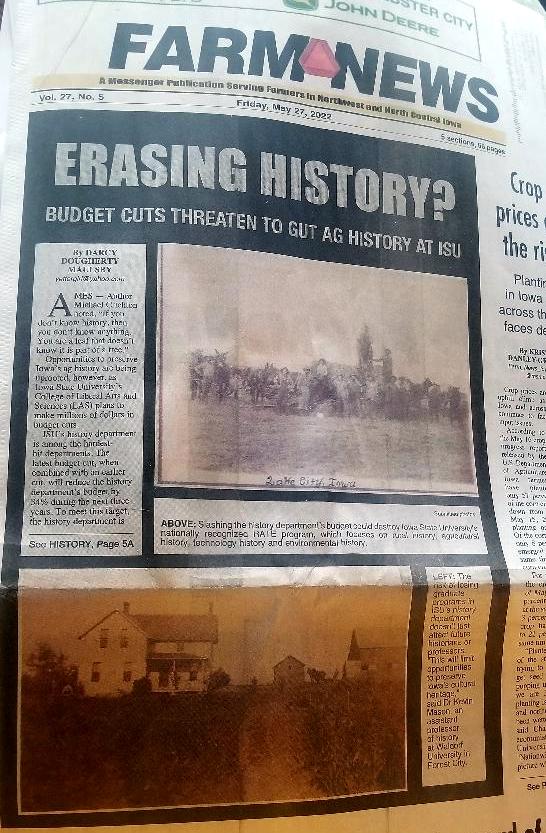
Erasing History? Budget Cuts Threaten to Gut Ag History at Iowa State University
Author Michael Crichton noted, “If you don’t know history, then you don’t know anything. You are a leaf that doesn’t know it is part of a tree.” Opportunities to preserve Iowa’s ag history are being uprooted, however, as Iowa State University’s (ISU) College of Liberal Arts and Sciences (LAS) plans to make millions of dollars in budget cuts.
ISU’s history department is among the hardest-hit departments. The latest budget cut, when combined with an earlier cut, will reduce the history department’s budget by 34% during the next three years. To meet this target, the history department is considering eliminating its graduate programs and search for further economies.
“The decisions made today influence the future,” said Michael M. Belding III, 31, a Ph.D. candidate studying rural, agricultural, technological, and environmental history at ISU. “I disagree with the budget cuts for ISU’s history department, because the people of Iowa deserve better.”
Belding has been gathering signatures to challenge these budget cuts, which would eliminate graduate programs in ISU’s history department.

Michael M. Belding III, a Ph.D. candidate studying rural, agricultural, technological, and environmental history at Iowa State University (ISU), has been gathering signatures to challenge severe budget cuts that would eliminate graduate programs in ISU’s history department.
He took action after Dr. Beate Schmittmann, LAS dean, announced a new round of budget cuts as part of her “Reimagining LAS” initiative. This is intended to “right-size” the budget in response to changing enrollment and student demand and “to position the college for future success,” according to ISU.
Slashing the history department’s budget will destroy ISU’s nationally-recognized RATE program, which focuses on rural history, agricultural history, technology history and environmental history. “If these proposed budget cuts occur, ISU is throwing away an innovative, important program,” noted Dr. Pamela Riney-Kehrberg, a distinguished professor of history at ISU.
If this happens, there will be long-lasting, negative impacts for Iowa, added Dr. Joe Anderson, a professor of history at Mount Royal University in Calgary, Alberta. “The Midwest has long been dynamic powerhouse of agriculture and innovation,” said Anderson, who earned his Ph.D. in history at ISU. “Everyone who cares about Iowa and its past should be mad as hell about ISU’s decision.”
Iowa’s ag heritage isn’t just for history majors
The risk of losing graduate programs in ISU’s history department doesn’t just affect future historians or professors. “This will limit opportunities to preserve Iowa’s cultural heritage,” said Dr. Kevin Mason, an assistant professor of history at Waldorf University in Forest City.
Not everyone who enrolls in history classes at ISU is a history major, added Mason, who received his Ph.D. in rural and environmental history from ISU in 2020. They include attorneys, engineers, architects and high school teachers who want to expand their knowledge of Iowa’s heritage. “If you care about Iowa history, you need to understand ag history.”
The only other university offering anything similar to ISU’s RATE program is Mississippi State University (MSU), although MSU focuses on Southern—not Midwestern—history. Neither the University of Iowa nor the University of Northern Iowa focus on ag/rural history, Riney-Kehrberg added.
“In most history courses and books, there’s little or no information on ag history following the Civil War,” noted Riney-Kehrberg, who researches American rural and agricultural history and will soon publish her latest book, When a Dream Dies: Agriculture, Iowa and the Farm Crisis of the 1980s. “The standard American history textbook might have one sentence about the Farm Crisis.”
The same dearth of information is evident when it comes to the role of women in agriculture. “There are many women’s studies courses today, but they often only teach the story of urban women, not rural women,” Riney-Kehrberg added.

“If these proposed budget cuts occur, ISU is throwing away an innovative, important program,” notes Dr. Pamela Riney-Kehrberg, a distinguished professor of history at Iowa State University.
History comes to life through the “land-grant land hunt”
While Yale University offers agrarian studies, it’s not the boots-on-the-ground style of research and extension that a land-grant university like ISU provides, Riney-Kehrberg noted.
Brandon Duxbury experienced this first-hand through the “land-grant land hunt” that ISU Extension undertook from 2014-2018. Contrary to popular belief, not a single acre of Story County land was given to Iowa State as part of the land-grant act (the Morrill Act) of 1862. Iowa was the first state to accept the provisions of the Morrill Act to build a college for the study of agriculture and the mechanical arts. Iowa Governor Samuel Kirkwood appointed Peter Melendy to select the best 210,000 acres of Iowa land to fund the new land-grant college. Most of this land was available in north-central and northwest Iowa.
Iowa became the first state to digitally map all these land-grant parcels within the state. Duxbury, a South Dakota native and graduate student in ISU’s history program, researched countless historical documents and interviewed current landowners to share their stories of their farmland. “People were always excited when we contacted them about this project,” said Duxbury, who is the new curator of collections at the Dacotah Prairie Museum in Aberdeen, South Dakota.
These stories, videos, a digital map and more can be found at www.landgrant.iastate.edu. “Efforts like this inspire people to ask better questions about the legacy they’re leaving with the land,” Duxbury said.
Making Iowa history relevant in ways like this is vital, said Belding, a Story City native who has links to his petitions on his Twitter account @mickey_belding. “I grew up thinking history involved big events that happened elsewhere, not here in Iowa. The more I research Iowa’s ag history, though, the more attached I get to Iowa.”
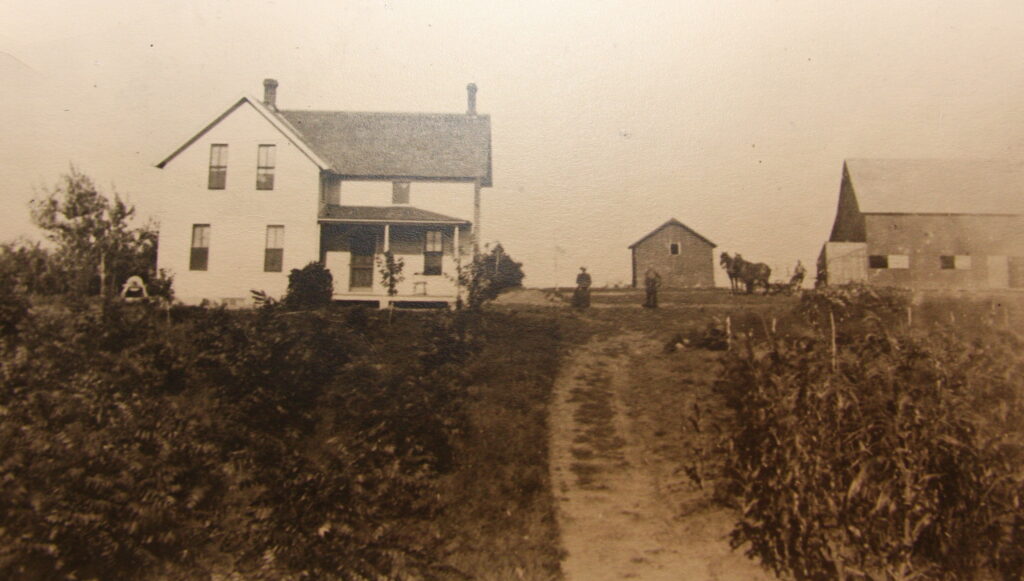
Family farms like this one near Yetter in Calhoun County have driven the economy in Iowa and the Midwest for generations. “The Midwest has long been dynamic powerhouse of agriculture and innovation,” says Dr. Joe Anderson, a professor of history at Mount Royal University in Calgary, Alberta, who earned his Ph.D. in history at Iowa State University (ISU). “Everyone who cares about Iowa and its past should be mad as hell about ISU’s decision.”
Teaching history prepares students for success
Along with researching and preserving Iowa history, ISU’s history department helps students develop a broad skill set, including communication. “My dad was a computer programmer who was promoted to management,” Riney-Kehrberg said. “He always emphasized that reading, writing and speaking skills were essential for a successful career.”
History classes also teach students research skills, data analysis and critical thinking. “You have to make an argument, and then find facts to support this argument,” Riney-Kehrberg said. “All this requires you to think carefully and broadly.”
Studies show that students with a solid LAS education, including history, have some of the best outcomes five years after college graduation. “These graduates tend to make more money, are the least likely to be fired, are less likely to move back home to live with their parents and are more likely to be promoted,” said Anderson, citing sources like the 2018 report “Humans Wanted: The Coming Skills Revolution,” published by the Royal Bank of Canada. “We’re very short-sighted as a culture if we devalue skills that come from studying the humanities.”
The “soft skills” of how people communicate with each other, interact with colleagues and solve problems are just as important to workplace readiness and employability as hard skills, especially as technology evolves. “It doesn’t take a ‘George Jetson’ moment to imagine a day when artificial intelligence and other technologies will replace some of the jobs we currently train people for,” Anderson, who served as director of history and interpretation at Living History Farms in Urbandale in the 1990s. “Our society will always need people who are skilled in human connection and communication.”
Society also needs educated citizens, both rural and urban, with a solid understanding of agricultural history, Anderson added. “People who are trained in ISU’s history department often go on to run museums in Iowa and the Midwest, teach at community colleges like DMACC or Hawkeye Community College, teach at land-grant universities, or pursue a variety of other careers.”
Everywhere they go, these professionals take Iowa history with them, noted Anderson, a south-central Nebraska native who loved spending time on his grandparents’ farms in Missouri and Iowa. He often incorporates Midwestern history into the classes he teaches in Canada. “This perspective helps people better understand many pressing issues today, from water quality to food production.”
Integrating history with tourism, economic development
It’s essential to be open to new ways of making Iowa history relevant to a wider audience, Mason said. “I believe history departments, especially at a land-grant like ISU, can collaborate across academic disciplines to help create a more diversified economy that encourages young people to stay in Iowa.”
Mason, who grew up in Pella, saw how Iowa history was intertwined with job creation, economic development and tourism in his hometown. “Tradition is important in Pella. Honoring this heritage helps young people gain a sense of place and the sense of pride that comes from knowing their history.”
Anyone who is concerned about the proposed funding cuts to ISU’s history department should contact their state legislators, the Board of Regents, and Dr. Beate Schmittmann, dean of the College of LAS at ISU. It’s important to take action now, Duxbury said. “The loss of ISU’s graduate history programs is a loss to Iowa history. Fighting these drastic cuts is a battle worth fighting.”
Note: I wrote this article for Farm News. It first appeared in the Friday, May 27, 2022, edition of Farm News. I’ve had a number of people ask me what they can do to fight these budget cuts. First, if you’re an Iowan, contact the senator and representative who represent you at the state level in the Iowa legislature. Also, contact leaders at ISU, including:
Iowa State University
Attn. Dr. Beate Schmittmann
202 Catt
2224 Osborn Dr.
Ames IA 50011-4009
Iowa State University
Office of the President, Dr. Wendy Wintersteen
515 Morrill Road
1750 Beardshear Hall
Ames, IA 50011
Want more?
I invite you to read more of my blog posts if you value intriguing Iowa stories and history, along with Iowa food, agriculture updates, recipes and tips to make you a better communicator.
If you’re hungry for more stories of Iowa history, check out my top-selling “Culinary History of Iowa: Sweet Corn, Pork Tenderloins, Maid-Rites and More” book from The History Press. Also take a look at my other books, including “Iowa Agriculture: A History of Farming, Family and Food” from The History Press, “Madison County,” “Dallas County” and “Calhoun County” book from Arcadia Publishing. All are filled with vintage photos and compelling stories that showcase the history of small-town and rural Iowa. Click here to order your signed copies today! Iowa postcards are available in my online store, too.
If you like what you see and want to be notified when I post new stories, be sure to click on the “subscribe to blog updates/newsletter” button at the top of this page, or click here. Feel free to share this with friends and colleagues who might be interested, too.
Also, if you or someone you know could use my writing services (I’m not only Iowa’s storyteller, but a professionally-trained journalist with 20 years of experience), let’s talk. I work with businesses and organizations within Iowa and across the country to unleash the power of great storytelling to define their brand and connect with their audience through clear, compelling blog posts, articles, news releases, feature stories, newsletter articles, social media, video scripts, and photography. Learn more at www.darcymaulsby.com, or e-mail me at yettergirl@yahoo.com.
Let’s stay in touch. I’m at darcy@darcymaulsby.com, and yettergirl@yahoo.com.
Talk to you soon!
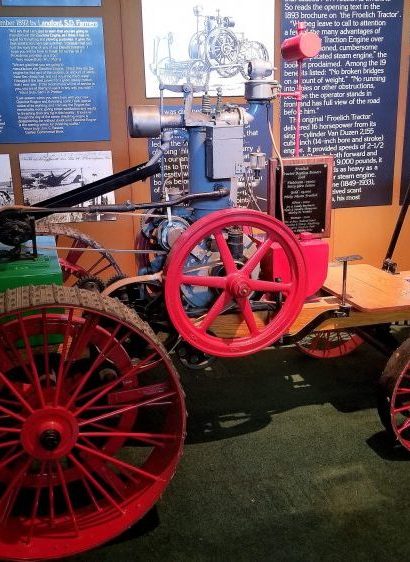
Machines that Changed America: John Froelich Invents the First Tractor in Iowa
Today, it’s hard to imagine a cornfield without a tractor in the picture. I was thinking about tractor history when The History Channel featured “The Machines That Built America.” I was glad to see they included the story of John Froelich, which I featured in my 2020 book Iowa Agriculture: A History of Farming, Family and Food.
Here’s an excerpt:
Back in 1892 in the tiny village of Froelich in Clayton County, Iowa, however, folks were amused by what a local businessman, John Froelich, was saying.
This northeast Iowa entrepreneur (1849 -1933) believed that mechanical power had a great future—that someday traction engines would do the work of horses even on mid-sized and large farms. The locals had to admit, though, that Froelich had invented several handy gadgets, including a more efficient washing machine, plus he was a good businessman.
Froelich ran a grain elevator, plus he ran a well-digging business and operated a threshing rig. Every year he took a crew of men to Langford, South Dakota, to work the fields. Froelich had considerable experience with steam engines and knew their pitfalls. They were heavy and bulky. They were hard to maneuver. They were always threatening to set fire to the grain and stubble fields. On the flat prairie, with a strong wind blowing, that was no joke.
A frustrated Froelich decided he could invent a better way to power the engine. The solution was gasoline. Froelich and local blacksmith Will Mann came up a vertical, one-cylinder engine mounted on the running gear of a steam traction engine – a hybrid of their own making. They designed many new parts to make it all fit together, but it finally was done. The word “tractor” wasn’t used in those days, but that’s what Froelich invented.
A few weeks later Froelich and his crew started for the broad fields of South Dakota with the “tractor” and a new threshing machine. That fall they threshed 72,000 bushels of small grain. It was a success!
Later that fall, Froelich shipped his “tractor” to Waterloo, Iowa, to show some businessmen. Immediately, the men formed a company to manufacture the “Froelich Tractor.” They named the company The Waterloo Gasoline Traction Engine Company and made Froelich the president.
Unfortunately, efforts to sell the practical, gasoline-powered tractor failed. Two were sold and shortly returned. The company then decided to manufacture stationary gas engines to provide income while tractor experiments continued, according to the Froelich Museum.
In 1895, the Waterloo Gasoline Engine Company was incorporated, but Froelich, whose interest was in tractors, not stationary engines, chose to withdraw from the company. The Waterloo Company continued to build stationary engines while trying to improve the tractor. In 1913 the model “L-A” was made.
In 1914, the first Waterloo Boy tractor, the Model “R” single-speed tractor, was introduced. Farmers liked it, and sales reached 118 within a year. When the Model “N” Waterloo Boy with two forward speeds was introduced, it was also successful.
When World War I led to rising farm prices and strong demand for dependable mechanical farm power, the concept of the tractor became so popular many tractor manufacturers sprung up in a matter of months. Deere and Company in Moline, Illinois, which manufactured a full line of John Deere implements, had been watching the progress of the Waterloo Engine Company and the increasing quality of its products.
Deere was looking for an established farm tractor to round out its line, and the Waterloo Engine Company fit the bill. Today, Deere’s facility in Waterloo remains one of the largest tractor-producing plants in the nation.
Tractors of various types and sizes that make farming easier and more efficient are shipped to farmers all over the world. For this contribution, John Froelich will long be remembered, and the village of Froelich, Iowa, remains “Tractor Town U.S.A.”
Tractor enthusiasts from around the globe travel to this tiny village to visit the birthplace of the tractor. At the 1891 general store, guests can view a scale model of the first “Froelich Tractor” made from the original blueprints. Perhaps the monument erected in 1939 near the general store best captures the essence of this unique place.
“In this village, John Froelich built the first gasoline tractor that propelled itself backwards as well as forward. Far-reaching in its effect on modern agricultural history, it moved out of this village and into the world in 1892. Later that year, Mr. Froelich joined with others in organizing the Waterloo Gasoline Traction Engine Company, which later became the John Deere Tractor Company.”
Meeting the challenge of a reliable, durable tractor
This history took center stage at the 2018 Iowa State Fair in Des Moines, when a butter sculpture of the Waterloo Boy Tractor stood next to the world-famous Butter Cow in the John Deere Agriculture Building’s 40-degree cooler throughout the fair, which ran from August 9-19.
To understand the significance of the Waterloo Boy, take a trip back in time, said Neil Dahlstrom, manager of the John Deere Archives and History. In the critical five-year stretch (1912-1917) prior to John Deere entering the tractor business, there were two key issues to address.
“First, what did farmers really want from a machine that would soon make the horse obsolete?” said Dahlstrom, who noted that salesmen, territory and branch managers, and Deere’s top leadership scoured the country to understand what customers desired. Also, how could the equipment to be manufactured to be durable enough to stand up to daily farm use?
Deere had considered every imaginable idea. The company had developed one-, two- and four-cylinder concept tractors. Some ran on gasoline. Others ran on kerosene. Some had all-wheel drive. Others had front-wheel drive. The company even explored concepts like line steering, which was meant to replicate horse reins as the steering mechanism to ease farmers into power farming, Dahlstrom said.
A motorized cultivator, what Deere called a “Tractivator,” was brought to market by several competitors, but Deere determined it did not provide any cost savings compared to horses.
The challenge of producing a durable tractor loomed large. In a letter to company president William Butterworth in 1915, Deere’s superintendent of factories George Mixter noted that tractors offered by competitors up to that point “have not been built with the proper spirit behind the design and manufacture to insure their durability in the hands of the farmers.” But if Deere could “build a small tractor that will really stand up for five or more years’ work on the farm, I believe they will be a permanent requirement of the American farmer,” Mixter wrote.
Deere ultimately found the solution with the Waterloo Boy tractor and acquired the Waterloo Gasoline Engine Company in Waterloo, Iowa, on March 14, 1918. Although anxious to start selling the Waterloo Boy, Deere dealers had to wait while Deere honored existing contracts, which did not expire until Dec. 31, 1918, Dahlstrom said.
Waterloo Boy makes its debut
Deere put its money where its instincts were. Over the next year, the company spent more than one-third of its advertising budget touting the Waterloo Boy tractor, Dahlstrom said.
Specifically, Deere invested $50,000 on tractor advertising in the year following its debut of the Waterloo Boy—approximately $747,000 in today’s money. Another way to get the company’s new product out in front of customers was to take it on the road – literally.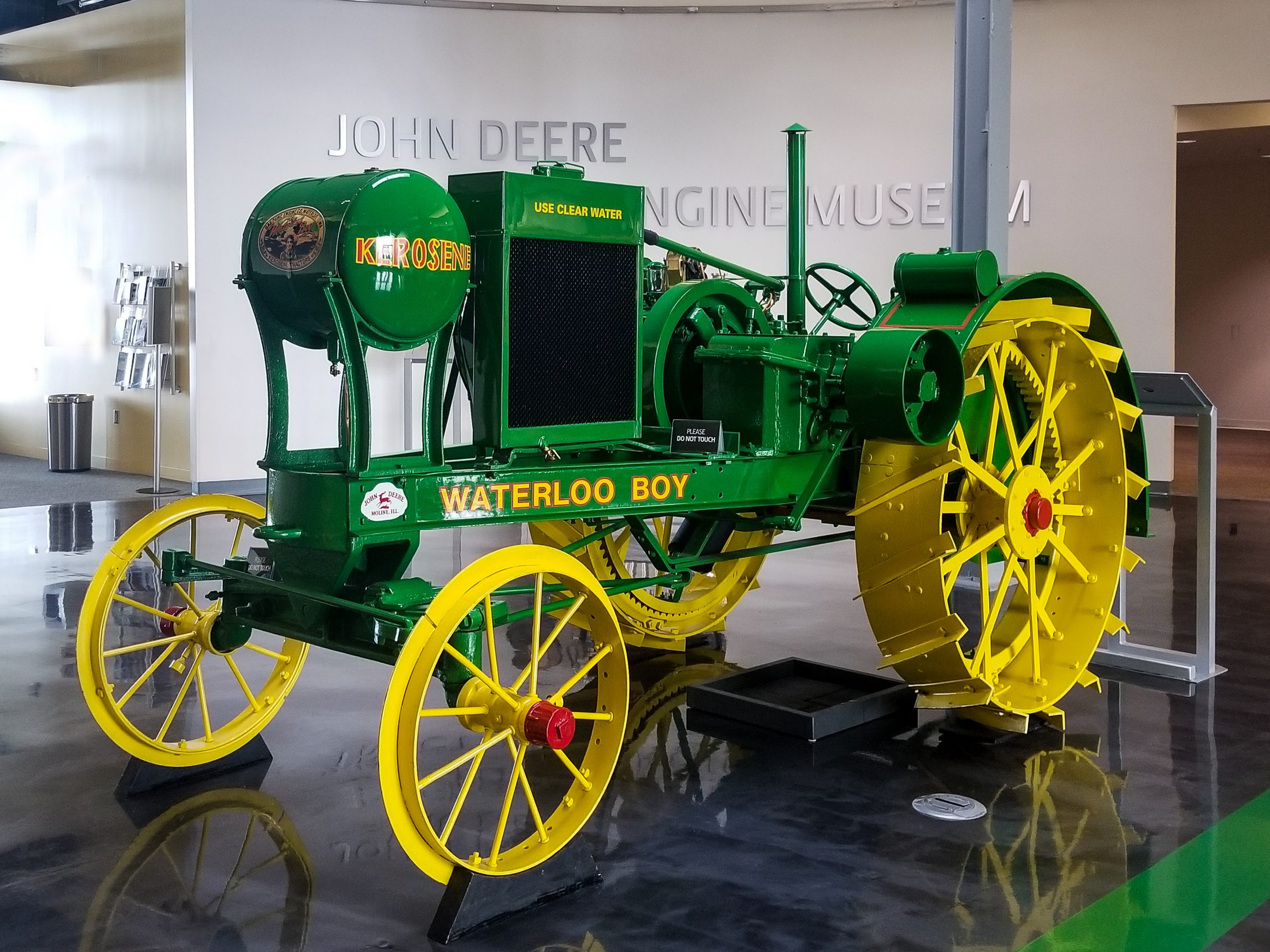 The National Tractor Demonstrations started to become more mainstream after being introduced in the United States in 1913. An eight-city, eight-week tour schedule was the perfect opportunity to unveil Deere’s Waterloo Boy, Dahlstrom said. Salina, Kansas, served as the ideal backdrop in August 1918, since this was the nation’s largest demonstration.
The National Tractor Demonstrations started to become more mainstream after being introduced in the United States in 1913. An eight-city, eight-week tour schedule was the perfect opportunity to unveil Deere’s Waterloo Boy, Dahlstrom said. Salina, Kansas, served as the ideal backdrop in August 1918, since this was the nation’s largest demonstration.
Deere had participated in tractor demonstrations since the original Winnipeg Agricultural Motor Competitions in Manitoba, Canada, in 1908 – but not with a tractor. Instead, Deere had paired its plows with leading tractor manufacturers. That changed now that the Waterloo Boy was part of the Deere family.
At Salina, Deere spared no expense, showcasing 12 Waterloo Boy tractors as the centerpiece of a display that included John Deere signs, Waterloo Boy signs and a copper leaping deer statue, Dahlstrom said. “There were two stars during this week of 100-degree days – ‘ice water on tap’ and the Waterloo Boy Model ‘N’ tractor,” he added.
The Model “N” demonstrated its merits by pulling tractor plows, disc harrows and grain drills. Visitors were shuttled in three John Deere farm wagons pulled by Waterloo Boy tractors. By all accounts, the debut was a success.
“The award for the most elaborate, largest and most artistic exhibit tent at the Salina tractor show will undoubtedly go to the John Deere Plow company of Kansas City,” wrote the editors of a Kansas City newspaper.
As Deere’s advertising campaign swung into full gear, the Waterloo Boy tractor was promoted as the “best and most efficient tractor” on the market for farmers inclined to buy a tractor. By October 1918, readers of Deere’s magazine, The Furrow, saw an advertisement for the line of Waterloo Boy tractors and stationary engines. The ad guaranteed the Waterloo Boy’s “ample power for field and belt work.”
In January 1919, with tractors now available through John Deere dealers, Deere’s first print ad for the trade press appeared in The Farm Implement News. It featured two areas of emphasis: “A Good Tractor Backed by a Permanent Organization.”
After years of development, John Deere customers and John Deere dealers finally had their John Deere tractor. “It took longer than the company expected, but a determination to do it right instead of doing it fast now brought the John Deere tractor to market,” Dahlstrom said.
As a result, customers got “the assurance of more tractor work per dollar of fuel cost; longer tractor life with less repair cost; accessibility of parts that makes caring for the tractor simple and easy; and dependable power for all farm work.”
The tractor era had officially arrived, and Iowa found itself at the epicenter of this growing industry.
Want more?
I invite you to read more of my blog posts if you value intriguing Iowa stories and history, along with Iowa food, agriculture updates, recipes and tips to make you a better communicator.
If you’re hungry for more stories of Iowa history, check out my top-selling “Culinary History of Iowa: Sweet Corn, Pork Tenderloins, Maid-Rites and More” book from The History Press. Also take a look at my other books, including “Iowa Agriculture: A History of Farming, Family and Food” from The History Press, “Madison County,” “Dallas County” and “Calhoun County” book from Arcadia Publishing. All are filled with vintage photos and compelling stories that showcase the history of small-town and rural Iowa. Click here to order your signed copies today! Iowa postcards are available in my online store, too.
If you like what you see and want to be notified when I post new stories, be sure to click on the “subscribe to blog updates/newsletter” button at the top of this page, or click here. Feel free to share this with friends and colleagues who might be interested, too.
Also, if you or someone you know could use my writing services (I’m not only Iowa’s storyteller, but a professionally-trained journalist with 20 years of experience), let’s talk. I work with businesses and organizations within Iowa and across the country to unleash the power of great storytelling to define their brand and connect with their audience through clear, compelling blog posts, articles, news releases, feature stories, newsletter articles, social media, video scripts, and photography. Learn more at www.darcymaulsby.com, or e-mail me at yettergirl@yahoo.com.
Let’s stay in touch. I’m at darcy@darcymaulsby.com, and yettergirl@yahoo.com.
Talk to you soon!

Bob Feller on Farming, Baseball and Military Service
Now that we’re in the time of the year when we take time to honor those who’ve served (Memorial Day), celebrate America (July 4) and maybe even catch a baseball game, I think about the time I interviewed Bob Feller, a Major League Baseball legend and Iowa farm kid.
I’m willing to bet that most people, if they are old enough to remember Feller, know him more for his pitching prowess with the Cleveland Indians. But Feller was also a decorated World War II veteran who gave up some of his prime years of playing professional baseball to serve his country.
“I’m very proud of our military and have a lot of respect for our troops,” said Feller (1918-2010) when I interviewed him in his hometown of Van Meter, Iowa, in 2003.
Known as the “Heater from Van Meter,” Feller signed a pro baseball contract with the Cleveland Indians when he was only 16. “Farm work made me a ball player,” Feller said. “When I was little, I was the water boy for the threshing crew. As I got older, I did it all—I cleaned the barn, milked cows, drove tractors and teams of horses, picked corn and threw bales of hay. Those bales really helped strengthen my arms.”
Feller’s father, Bill, was his first coach. “When I was a kid, Dad built a ball field we called Oak View. That was the first Field of Dreams—not that one from the movies.”
Feller grew up playing baseball at vacation Bible school at the Methodist Church in Van Meter. He also played four years of American Legion baseball in Adel, where his catcher was Nile Kinnick, a future University of Iowa football star who would enlist in the Navy Air Corps Reserve three days after the attacks on Pearl Harbor.
Feller’s father spent hours helping his son develop his baseball skills. “Dad would hit ground balls to me in the hog lot and pitch batting practice to me. We’d practice every night we could. When Mom would call us for supper, we’d always tell her we could eat after dark, but we couldn’t play ball after dark.”
“I never thought twice about enlisting”
By the time Feller played his first game in the major leagues in 1936, the teenaged pitcher struck out 15 St. Louis Browns. Later that season, at age 17, Feller set a new American League record by fanning (striking out) 17 Philadelphia Athletics. In Chicago in 1940, Feller pitched his first of three no-hitters and the only no-hitter pitched on opening day in major league history.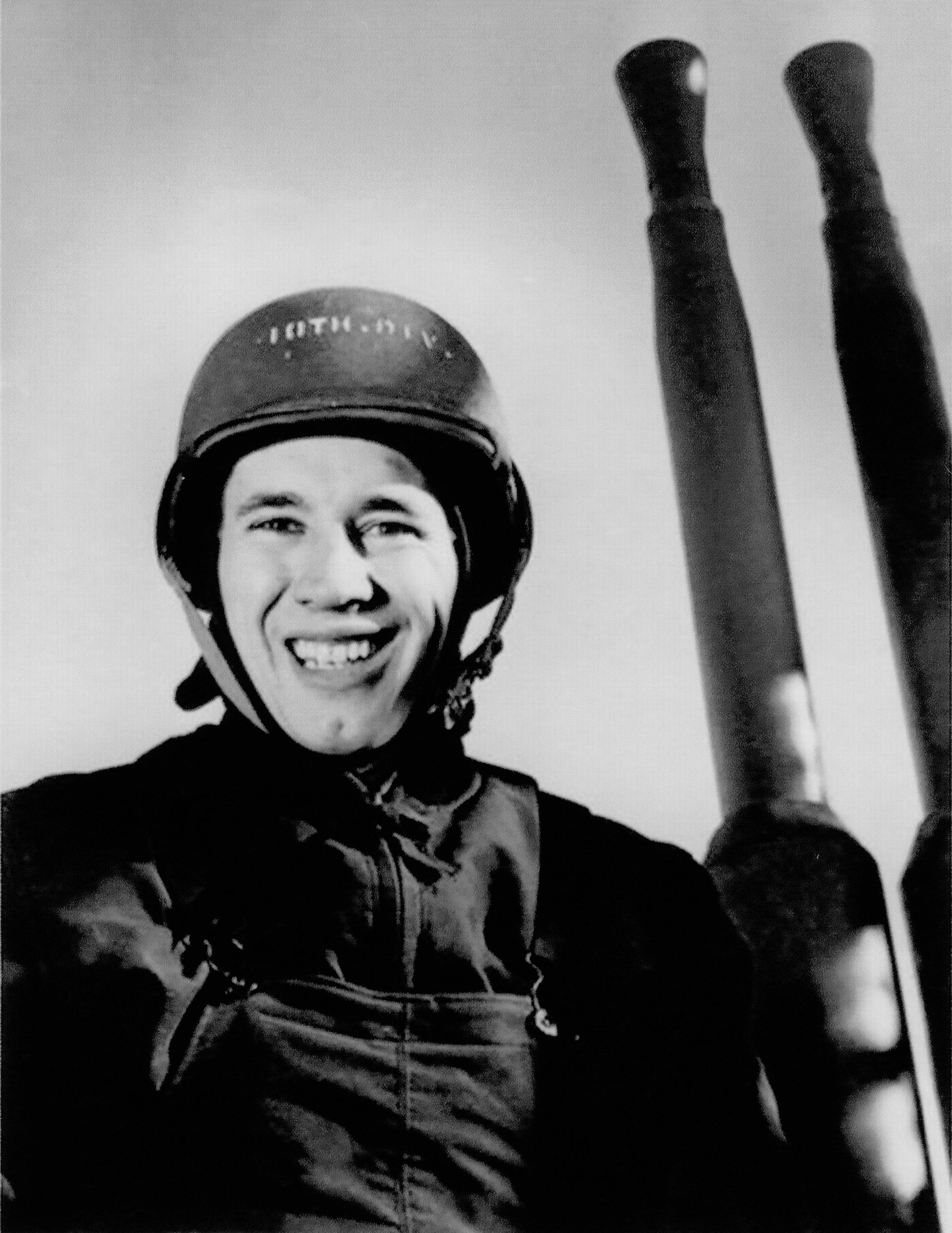 On the eve of World War II, Feller was playing in the big leagues with stars like Ted Williams and Joe DiMaggio. By the time Feller enlisted in the Navy two days after the Pearl Harbor attacks on December 7, 1941, the 22-year-old star had already set a number of major league records.
On the eve of World War II, Feller was playing in the big leagues with stars like Ted Williams and Joe DiMaggio. By the time Feller enlisted in the Navy two days after the Pearl Harbor attacks on December 7, 1941, the 22-year-old star had already set a number of major league records.
While some say Feller’s military service took away what could have been some of his most productive years, Feller doesn’t see it that way.
“I never thought twice about enlisting. I played a little baseball during boot camp in Norfolk, Virginia, before I became an anti-aircraft gun captain on the USS Alabama for 34 months.”
Feller was awarded eight Battle Stars during his years of service. When the war ended, Feller resumed his baseball career with the Cleveland Indians in the late summer of 1945. “I’m no hero,” emphasized Feller, who was inducted into the Hall of Fame in 1962, after retiring from baseball in 1956 at age 37. “I’m just a survivor. The men who never returned home to this country were the heroes.”
Maybe Feller’s story resonates me so much because I, too, come from rural Iowa, and I’ve been blessed to know many friends and family members who have served our country. America is home to a significant percentage of veterans. In 2011–2015, nearly one fourth (24.1 percent) of the veteran population 18 years and older lived in areas designated as rural, according to census.gov.
While we don’t know them all, we owe them all. Thanks to you all, and thanks to patriots like Bob Feller who was willing to serve when his country needed him. America truly is the home of the free because of the brave.
Want more?
I invite you to read more of my blog posts if you value intriguing Iowa stories and history, along with Iowa food, agriculture updates, recipes and tips to make you a better communicator.
I’ve shared more Bob Feller stories and photos in my Iowa history book “Dallas County.”
If you’re hungry for more stories of Iowa history, check out my top-selling “Culinary History of Iowa: Sweet Corn, Pork Tenderloins, Maid-Rites and More” book from The History Press. Also take a look at my other books, including “Iowa Agriculture: A History of Farming, Family and Food” from The History Press, “Madison County,” “Dallas County” and “Calhoun County” book from Arcadia Publishing. All are filled with vintage photos and compelling stories that showcase the history of small-town and rural Iowa. Click here to order your signed copies today! Iowa postcards are available in my online store, too.
If you like what you see and want to be notified when I post new stories, be sure to click on the “subscribe to blog updates/newsletter” button at the top of this page, or click here. Feel free to share this with friends and colleagues who might be interested, too.
Also, if you or someone you know could use my writing services (I’m not only Iowa’s storyteller, but a professionally-trained journalist with 20 years of experience), let’s talk. I work with businesses and organizations within Iowa and across the country to unleash the power of great storytelling to define their brand and connect with their audience through clear, compelling blog posts, articles, news releases, feature stories, newsletter articles, social media, video scripts, and photography. Learn more at www.darcymaulsby.com, or e-mail me at yettergirl@yahoo.com.
Let’s stay in touch. I’m at darcy@darcymaulsby.com, and yettergirl@yahoo.com.
Talk to you soon!
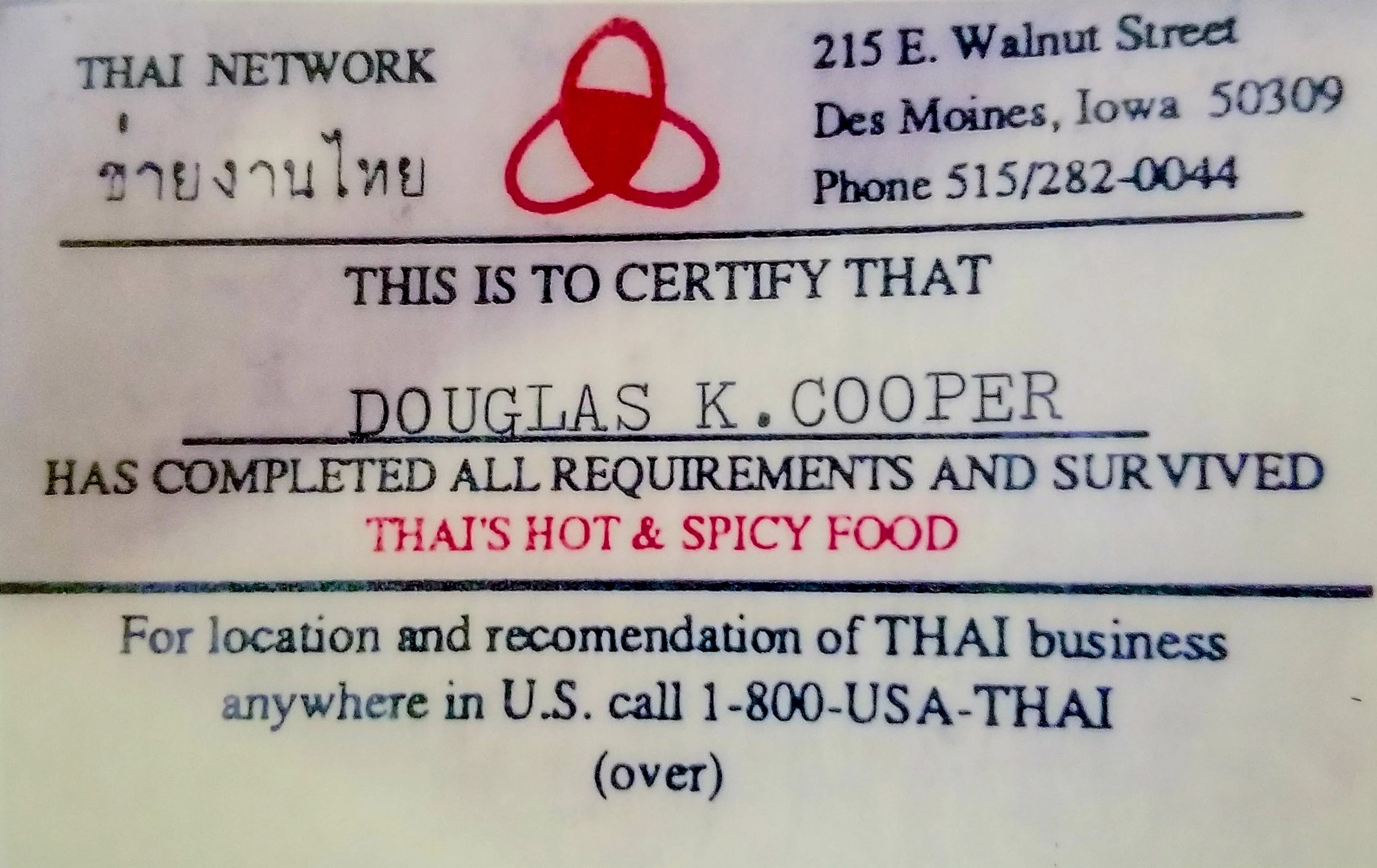
Classic Restaurants of Des Moines: A Taste of Thailand Served the “Publics” and Politics
Have you ever seen a bird fly backwards? Are you able to touch your toes? Whom will you vote for? All this and more defined A Taste of Thailand, a classic restaurant of Des Moines. This may have been the only restaurant in the world with a home-made voting booth. The quixotic T.O.T. Polls (Taste of Thailand) polls and the delicious Thai food practically made A Taste of Thailand a mandatory stop for presidential candidates and reporters covering the Iowa caucus.
The Taste of Thailand in downtown Des Moines became a dining destination during the 1980s for locals and visitors. Thai natives Prasong “Pak” Nurack and Benchung “Beni” Laungaram, his wife, opened their popular restaurant in December 1983, in an abandoned auto repair shop, repainted bright yellow. “So the publics will know we are here,” Pak said.
It may have been the only restaurant in the world with a home-made voting booth. The quixotic T.O.T. Polls (Taste of Thailand) polls and the delicious Thai food practically made A Taste of Thailand a mandatory stop for presidential candidates and reporters.
Years before Pak opened Des Moines’ original Thai restaurant, and decades before Pak would become a Thai national senator, he ran a diner on Court Avenue called Little Joe’s. Thai cuisine was a new thing in Des Moines when Pak and his wife introduced their native food on weekends at Little Joe’s.
In the late 1970s, most Iowans knew little about south and southeast Asian cuisines, noted Jim Duncan, a food writer from Des Moines. Pak, however, was a big personality who could easily talk people into trying something new.
He later moved his family’s restaurant to a place in the 200 block of East Walnut in Des Moines, opened another restaurant in Iowa City and eventually returned to Asia to pursue his political career in Thailand’s Senate.
Before that, however, Pak began capturing media attention in the mid-1980s for his distinctive food and his restaurant’s political flair.
“Candidates, news organizations and special-interest groups have spent thousands of dollars on polls trying to determine which men Iowa caucus-goers will anoint as front-runners for the 1988 presidential nominations,” noted the Chicago Tribune in the November 24, 1987, article “Forget Costly Polls: Eat Thai to Find Out Who’s Winning Iowa.” “They could have saved a lot of money and gotten a good meal in the process by checking out the results posted on a wall of the one and only Thai restaurant in the capital of cornfed beef.”
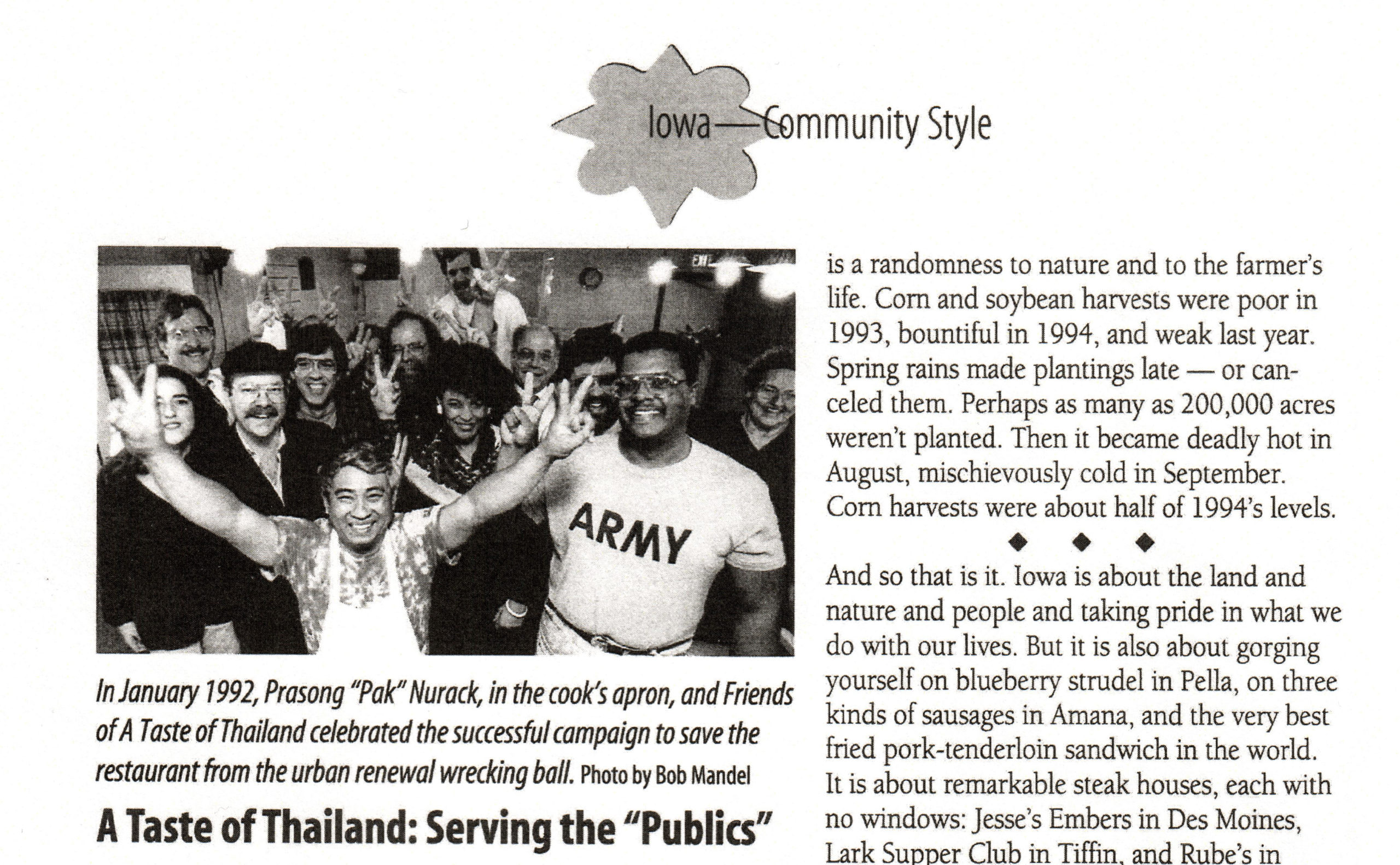 The article noted Pak, 45, was a lawyer who held a masters degree in political science. His bright yellow restaurant, located in the shadow of the gold-domed state capitol, was frequented by politicos, activists and others lured by the food and informal polls. Diners at Taste of Thailand received a ballot with the menu and could vote at the table or in a makeshift voting booth. Ballots were then placed in a box next to one poster showing the most recent results and another that said, “Road to the,” and then featured a picture of the White House.
The article noted Pak, 45, was a lawyer who held a masters degree in political science. His bright yellow restaurant, located in the shadow of the gold-domed state capitol, was frequented by politicos, activists and others lured by the food and informal polls. Diners at Taste of Thailand received a ballot with the menu and could vote at the table or in a makeshift voting booth. Ballots were then placed in a box next to one poster showing the most recent results and another that said, “Road to the,” and then featured a picture of the White House.
Pak insisted there is no ballot stuffing. ”I tell them to look at the ballot box where it says ‘honesty’ on it,” he told the Chicago Tribune. “And I tell them: Please, just one vote.’” He also supplies real voter registration cards. With his low-tech sampling process, Pak could be surprising accurate with polling results.
“About a week before the most recent CBS-New York Times poll and three weeks before the most recent Des Moines Register Iowa Poll, the unscientific sample of diners at the Taste of Thailand restaurant had determined that Sen. Paul Simon (a Democrat from Illinois) and Sen. Bob Dole (a Republican from Kansas) were the choice of the moment in their respective parties,” the Chicago Tribune noted in 1987. Dole would win the 1988 Iowa caucus on the Republican side, while Simon would finish a fairly close second that year to Rep. Richard Gephardt, a Democrat from Missouri.
Three candidates came to call on Pak personally in 1987, including Sen. Simon, Sen. Joseph Biden (a Democrat from Delaware), and Republican Alexander Haig, the U.S. Secretary of State under President Ronald Reagan and the White House chief of staff under presidents Richard Nixon and Gerald Ford. “But the restaurateur has withheld endorsement, saying he didn’t want to influence the poll,” the Chicago Tribune noted. Pak did say Haig showed “courage for coming to a restaurant where most of the patrons are liberal and Democrat.”
“Nobody lies”
How did a unique character like Pak come to Des Moines? When he was a lawyer in Thailand, Pak had dreamed of touring America after reading about it in books and seeing it on the news.
He moved to Chicago in 1971 to study political science. “I like politics, and you learn that all the players in the world know about politics in the United States,” Pak told the Chicago Tribune. “I wanted to learn something more.”
He worked part time washing dishes at the Rodeway Inn near O’Hare International Airport while he earned his masters degree in political science from Northeastern Illinois University. While Pak and his wife considered going back to Thailand, they wanted to see what smaller towns were like and headed west from Chicago. “This was the first big town we found,” he said of Des Moines. “We decided to stay. Its an agricultural town and instead of rice fields, we see cornfields. That’s nice.”
Pak and his wife became acquainted with many people in Des Moines. “They are interesting people. We talked issues over and we had something in common.”
It was during the discussions with patrons that Pak decided to conduct an informal poll of public opinion, partly as a marketing device for his restaurant and partly to keep discussions of current issues alive.
Fascinated by American politics, Pak decided to begin a monthly poll in 1986. He started asking serious and not-so-serious questions, ranging from people’s feelings about Farm Crisis to their favorite pet. The move to presidential politics was a natural next step. “People come here to eat, but they talk about politics,” Pak said.
Amazingly, the results of Taste of Thailand Polls have never been far off from more established surveys. A New York Times/CBS News survey released Oct. 31, 1987, for example, showed that Sen. Paul Simon had made a dramatic leap and was edging ahead of the Democratic presidential pack in Iowa for the first time, reported the November 27, 1987, issue of the New York Times.
“The Taste of Thailand poll showed the same thing a week earlier,” Maureen Dowd noted in her article “Iowa Restaurant Serves Up Sweet and Sour Poll Results.”
“We get pretty good information,” the “ebullient” Pak told Dowd. “’Nobody lies.”
The newspaper explained how Taste of Thailand, which featured a cosmopolitan beer list of 259 brands from 36 countries, catered to presidential candidates, political operatives, city and state officials, journalists and lobbyists for farm groups. “This,” Pak said, pulling out a camera to take a few candid shots of a CNN-TV crew having dinner, “is the same camera that took pictures of Joe Biden and Paul Simon eating here.” During Taste of Thailand’s polls, patrons wrote down their political preferences, either in the privacy of the restaurant’s curtained polling booth or in the more convivial atmosphere of their tables.
During Taste of Thailand’s polls, patrons wrote down their political preferences, either in the privacy of the restaurant’s curtained polling booth or in the more convivial atmosphere of their tables.
While the Taste of Thailand’s political polls drew the New York Times’ interest, Dowd couldn’t resist sharing results from the restaurant’s general-interest polls. People were interested in talking about reincarnation (37 percent of those polled at Taste of Thailand believed in it); television shows and talk show hosts (67 percent said they preferred ”MAS*H” to Johnny Carson); touching your toes (76 percent replied they could do it and 24 percent, presumably out-of-shape respondents, called it a silly question), and where disgraced televangelists Jim and Tammy Bakker will end up (the majority felt that Switzerland, rather than heaven or hell, was their destination).
No matter your opinion on politics or other pressing issues of the day, everyone agreed on two things. Taste of Thailand’s food was great, and it could be HOT.
“Taste of Thailand was the place to be,” recalled John Busbee, who hosts the Culture Buzz show on 98.9 KFMG Radio in Des Moines every Wednesday from 11 a.m. to 1 p.m.
While Busbee preferred to stick to chicken and vegetable dishes, adventurous eaters could find plenty of excitement. On the statistically coldest day each year in Des Moines (which usually occurred in February), the restaurant sponsored International Hot and Spicy Food Day. Pak and his team offered a buffet with all the hot food you could eat, along with all the cold beer you could drink.
You even had to sign a waiver stating you knew what you were getting into if you chose to try to the buffet, as if names of foods like “suicidal beef” and “angry shrimp” weren’t a big enough clue. “I enjoy spicy food, but that was way too much,” Chef Formaro said.
It’s hard to forget Taste of Thailand’s spicy food, said Coleen (Hildreth) Myers, who grew up in Lake City, Iowa, and now lives in Ankeny. In the late 1980s, Myers’ friend from India married a man from Thailand. She became acquainted with the couple at Iowa State University in Ames. Myers was invited to the couple’s wedding at the Episcopalian church in downtown Des Moines, as well as the reception, which included a sit-down dinner at Taste of Thailand.
“It was a very fancy dinner, and I vowed to try everything, but some of it was so hot that one bite was about all I could handle,” Myers said. “It was an experience I will never forget.”
Want more?
This story is just one of the many memories in my book Classic Restaurants of Des Moines and Their Recipes.” Check it out here.
I invite you to read more of my blog posts if you value intriguing Iowa stories and history, along with Iowa food, agriculture updates, recipes and tips to make you a better communicator.
If you’re hungry for more stories of Iowa history, check out my top-selling “Culinary History of Iowa: Sweet Corn, Pork Tenderloins, Maid-Rites and More” book from The History Press. Also take a look at my other books, including “Iowa Agriculture: A History of Farming, Family and Food” from The History Press, “Dallas County” and “Calhoun County” book from Arcadia Publishing. All are filled with vintage photos and compelling stories that showcase the history of small-town and rural Iowa. Click here to order your signed copies today! Iowa postcards are available in my online store, too.
If you like what you see and want to be notified when I post new stories, be sure to click on the “subscribe to blog updates/newsletter” button at the top of this page, or click here. Feel free to share this with friends and colleagues who might be interested, too.
Also, if you or someone you know could use my writing services (I’m not only Iowa’s storyteller, but a professionally-trained journalist with 20 years of experience), let’s talk. I work with businesses and organizations within Iowa and across the country to unleash the power of great storytelling to define their brand and connect with their audience through clear, compelling blog posts, articles, news releases, feature stories, newsletter articles, social media, video scripts, and photography. Learn more at www.darcymaulsby.com, or e-mail me at yettergirl@yahoo.com.
Let’s stay in touch. I’m at darcy@darcymaulsby.com, and yettergirl@yahoo.com.
Talk to you soon!

Want to Combat Fake News? Become a Better Researcher
Finding information in our digital world has never been easier, but there’s a dark side. Fake news seems to lurk everywhere, wielding the power to misinform and mislead.
How do you get closer to the truth? I asked Pati Daisy, a retired teacher-librarian from my hometown of Lake City, Iowa, to share her expertise. Here’s to keepin’ it real.
I know it takes time to research properly. Why is it valuable to invest the time?
It forces a person to slow down, think for a bit, and ask is the statement in question is a fact, opinion, myth or some blend of the three. Also, question the hidden agenda behind the statement’s presenter(s). What is the stated or unstated bias? What is the goal behind the statement? Who is the intended audience? How is that audience being manipulated?
What are the top 2 or 3 things that drive you crazy when it comes to people failing to research properly?
The thing that disturbs me the most is not that people fail to research properly as much as they fail to research at all. I will lay that blame squarely on a failure of our education system.
Here’s where is gets personal. I am a librarian. I ended my career as a teacher-librarian, but early in my career, librarians were not really seen as teachers as much as selectors and dispensers of information. We were taught how to evaluate, select and maintain information sources that would support a school curriculum. Publishers had editors whose role was to verify or at least help to ensure what was published was authoritative and useful to the intended audience. After all, there is considerable investment in publishing a book.
For a long time, this system was good enough. One person in a school or school district who knew how to do that was good enough. As long as carefully selected information sources were made available to educators and students alike, people really didn’t have to do much authentic re-search. But this is no longer the case. I believe there is not nearly enough being done in our schools to help staff and students learn and be held accountable for those skills.
Students will go to Wikipedia and the first results from Google if they are allowed to do so. It’s just so easy. Teachers today should maybe not accept those things as legitimate resources without some restrictions.
That being said, the Wikipedia of today is vastly improved over its beginnings. I would advise students, staff and general public to start there. It’s a good place to get a general overview or an outline of a topic. I would not allow Wikipedia articles as a source for a student research paper, however, but people can often find out the questions they didn’t even know to ask. Furthermore, Wikipedia now often lists a great number of sources to support their articles. Students and even the general public may well want to start there.
As for the first few Google hits, there are probably whole college courses on how to manipulate search engines, how some sites pay to be higher on the results list, and how sites are constructed so that the search brings the site higher in the results list. Suffice it to say, there’s no inter-net help-desk librarian sitting there answering your question. Search engines like Google are computer programs that have been carefully created (by humans) to specifically bring certain websites up first.
Many people say they don’t know how to combat fake news, because they don’t know where to go for information they can trust. Any advice on how people can sort fact from fiction?
I don’t know that the average person can truly combat fake news. but they can learn more about news and media sites. There are a couple of media bias charts that will help people to recognize the potential bias of particular new/media organizations.
Two that I recommend All Sides Media Bias Chart and Ad Fonets Inter-active Media Bias Chart.
One of my favorite quotes is from Mark Twain, who said “It’s better to remain silent and thought a fool than to open your mouth and remove all doubt.” Did Twain really say this? Upon further research I find that this saying (or a similar wording) has been attributed to Twain, Abraham Lincoln, Samuel Johnson, and the Book of Proverbs, among others. An unskilled researcher runs the risk of falling down the proverbial rabbit hole when trying to verify something. It’s difficult, and far too many haven’t been taught how to do it.
 My best advice is to always question the source.
My best advice is to always question the source.
There are several things to look for when trying to determine the veracity of a source. When I taught information skills I used the mnemonic RAD-CAB™ which teaches you to consider these six key points:
1. Relevance
2. Appropriateness
3. Detail
4. Currency
5. Authority
6. Bias
Another mnemonic is called The CRAAP Test (I know, don’t you just love that?) The researcher is asked to consider:
• Currency
• Relevance
• Authority
• Accuracy
• Purpose
As you evaluate sources, start with the basics.
1. Learn how to read the URL. For example, is it a:
– .com – a commercial site, trying to sell
– .edu – from an educational institution, trying to inform
– .org – an organization, trying to persuade
– .gov – government
– .mil – military
– Country designation: .uk – United Kingdom, .il – Israel, .ru – Russia, .no – Norway, and so on
2. Consider the source. My pet peeve is satire sites. Don’t get me wrong, I love satire, but satire is currently being used to inflame emotions. Those sites cater to the gullible, eliciting an immediate gut reaction of outrage. Too often, an outraged reader will then share the site or story, and others become inflamed. That immediate sense of outrage should be followed by these questions Really? Is this true? Who says?
You can try to answer those questions by:
– Going to the website home page and looking for the About Us page. This is something I nearly always do before I even think about re-posting something. I want to know who originally posted it and what their purpose is. The About Us section is usually located in very small letters at the very bottom of the webpage. It is often rather hard to find, by design, I might add. If it is not there, that should be your first red flag.
– Find out who is the author or group behind the page.
– Find out what their credentials are. What gives them authority in the particular subject they are presenting?
– Above all, try to determine the intention, purpose, bias and point of view of the site.
Since researching could be an never-ending process, if you let it, how you do draw the line?
The decision to stop researching depends greatly on your purpose. Are you simply looking for some quick fix, some validation of your strongly held opinion? Or are you verifying a statement or idea for its accuracy? Are you truly seeking to further and more deeply understand a statement, idea, concept, etc.? Are you seeking to learn if there is another viewpoint on that topic?
What’s your advice about analyzing bias when researching?
It has been often said that the pen is mightier than the sword. I believe that is true. Swords, guns, weapons of war do one thing and do it well. They kill, and whoever kills the most wins. The pen or words, if you will, can be subtly woven, bent, twisted and manipulated with the sole purpose of influencing the reader/listener/viewer. Words have power. Just as responsible gun owners learn and practice proper gun safety, so should we all learn and practice proper evaluation of any information we consume. We need to always be aware that there is the potential for bias in everything we hear, read or see.
Every human being has some type of bias, but just because we may believe something does not make it true. We need to question, always.
Keep in mind:
– Political viewpoint
– Purpose – such as to inform, persuade or sell
– Who is financially supporting the publication or website?
– How is the opposing view of the topic handled?
Does the author or site:
– Use extreme all-or-nothing type words?
– Use words that appeal to emotion?
– Use words that oversimplify or generalize?
– Present a limited view?
– Cite the sources used?
The New Jersey Institute of Technology has a very good explanation of things you should keep in mind as you check for bias. Click here for details.
Anything else you’d like to add about how to research properly?
The admonition “let the buyer beware” has never been more crucial.
My final word is to remember that anyone can produce and post anything on the internet now. There is no “librarian in the sky” skillfully evaluating and selecting information for us. We have to do that important job ourselves.
It’s too easy not to, but it’s so important that we must. We must learn, we must question, and we must think.
Want more?
I invite you to read more of my blog posts if you value intriguing Iowa stories and history, along with Iowa food, agriculture updates, recipes and tips to make you a better communicator.
If you’re hungry for more stories of Iowa history, check out my top-selling “Culinary History of Iowa: Sweet Corn, Pork Tenderloins, Maid-Rites and More” book from The History Press. Also take a look at my other books, including “Iowa Agriculture: A History of Farming, Family and Food” from The History Press, “Dallas County” and “Calhoun County” book from Arcadia Publishing. All are filled with vintage photos and compelling stories that showcase the history of small-town and rural Iowa. Click here to order your signed copies today! Iowa postcards are available in my online store, too.
If you like what you see and want to be notified when I post new stories, be sure to click on the “subscribe to blog updates/newsletter” button at the top of this page, or click here. Feel free to share this with friends and colleagues who might be interested, too.
Also, if you or someone you know could use my writing services (I’m not only Iowa’s storyteller, but a professionally-trained journalist with 20 years of experience), let’s talk. I work with businesses and organizations within Iowa and across the country to unleash the power of great storytelling to define their brand and connect with their audience through clear, compelling blog posts, articles, news releases, feature stories, newsletter articles, social media, video scripts, and photography. Learn more at www.darcymaulsby.com, or e-mail me at yettergirl@yahoo.com.
Let’s stay in touch. I’m at darcy@darcymaulsby.com, and yettergirl@yahoo.com.
Talk to you soon!
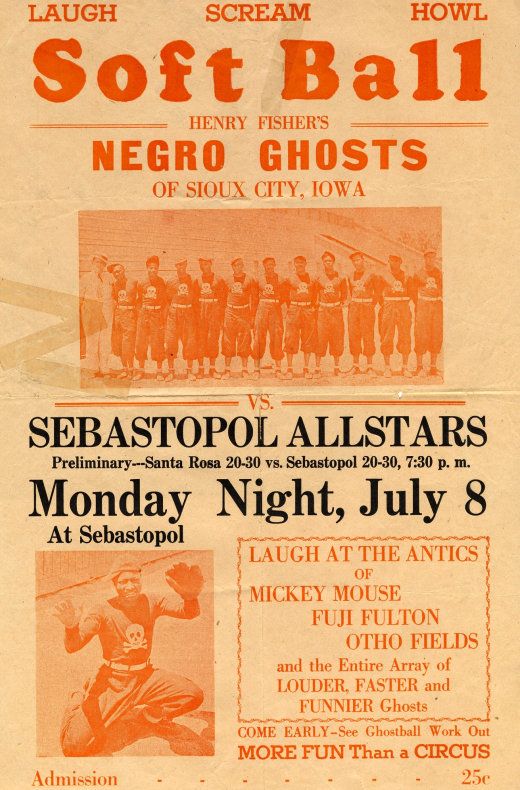
Remembering the African-American Sioux City Ghosts Fast-Pitch Softball Team
Even though owners and players of Major League Baseball are at an impasse trying to negotiate a 2020 season, there are still some noteworthy “boys of summer” stories to share, thanks to Iowa history. Perhaps no team brought more excitement to Iowa farm towns and cities across the country than the Sioux City Ghosts, a legendary African American fast-pitch softball team that got its start nearly 100 years ago.
“The Sioux City Ghosts were a big deal across the nation and internationally,” said Haley Aguirre, archival records clerk with the Sioux City Public Museum, which preserves some of the Ghosts’ history.
Because of their pranks on the softball field, the Sioux City Ghosts were often compared to the famous Harlem Globetrotters. The Sioux City team’s exceptional athletic skills, winning record and razzle-dazzle style of playing generated a level of excitement few teams have matched.
The team stemmed from a boys’ club the West 7th Street neighborhood of Sioux City, which was home to many African-American homes and businesses. This boys’ club team started with about 40 members in 1925. Many of the boys were brothers, and most players thought of their team as a family. Soon after forming, they became Sioux City’s Junior League champions, according to siouxcityhistory.org.
As the team members grew up, they entered Sioux City’s Senior League and again won the championship game. As they became well known in Sioux City, they received sponsorship from local businessman Jack Page. They wore uniform shirts with the team name – Jack-The Cleaners, but had no uniform pants. Instead, they wore whatever they owned, from jeans to bib overalls.
With the sponsorship of Jack’s, the softball team began playing in the tri-state area, but mostly in Iowa. As they toured, the nation was falling deeper into the Great Depression. Baseball and softball helped people forget about the poor economy, if only for a little while.
The Sioux City team grew in popularity the more the players toured. By 1933, they were known as the Sioux City Ghosts. Henry “Fats” Fisher became their first manager. That same year they also had a new sponsor, Whitney Cleaners, along with new uniforms. The black shirts and pants featured an orange skull and crossbones logo, which became the symbols of the Ghosts.
In 1934, Fisher convinced the Ghosts to tour in California, but only after their Iowa tour was complete. The players were an immediate hit in California, thanks to a few improvised comedy routines on the field.
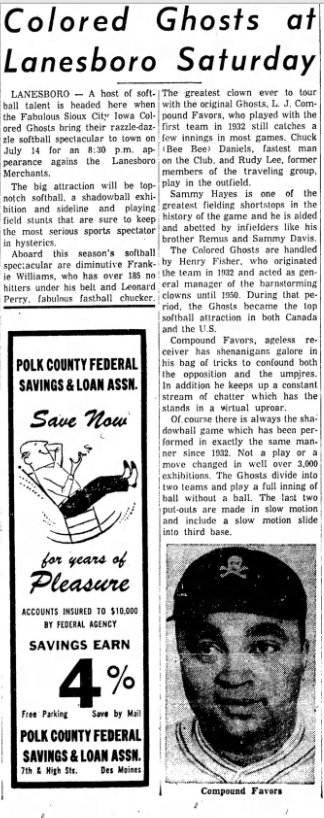
Pitching style and substance
Starting in the early 1930s, the team began concentrating on the comedy routines and pranks for their games. One of the Ghosts’ favorite routines was shadowball. A Carroll Daily Times Herald article from July 12, 1962, described the spectacle.
“Of course, there is always the shadowball game, which has been performed in exactly the same manner since 1932. Not a play or a move changed in well over 3,000 exhibitions. The Ghosts divide into two teams and play a full inning of ball without a ball. The last two put-outs are made in slow motion and include a slow-motion slide into third base.”
The Ghosts were true showmen, sometimes pitching melons instead of softballs. They also rode bicycles in the outfield. Showcasing these stunts didn’t mean the Ghosts’ record suffered, though. They team often played the best amateur teams cities had, including farm leagues, all-star teams and state champions. The Ghosts won more than 2,000 games and lost less than 100 games during a 20-year span, noted siouxcityhistory.org. The Ghosts even challenged the Harlem Globetrotters’ softball team to a game, although the game was never played.
The Ghosts toured Canada and the western United States, playing in Las Vegas, Phoenix and San Francisco. Some of the Ghosts’ games attracted huge audiences. In Vancouver, Canada, 26,000 people came to watch the game.
While the Sioux City Ghosts were celebrated on the field, things were much different when the game was over. Many of the better players tried to move into the professional leagues, but couldn’t because they were black.
“The Ghosts actually didn’t play in a league,” Aguirre added. “They toured and basically played anyone who would get on the field with them. They faced substantial racism and prejudice, and were often at the mercy of those living in the towns they visited.”
The team broke up at the beginning of World War II when many of the players entered the armed forces. The Ghosts resumed playing as a team, however, after the war. While players from other teams were added from time to time, the Ghosts always remained a mostly Sioux City team.
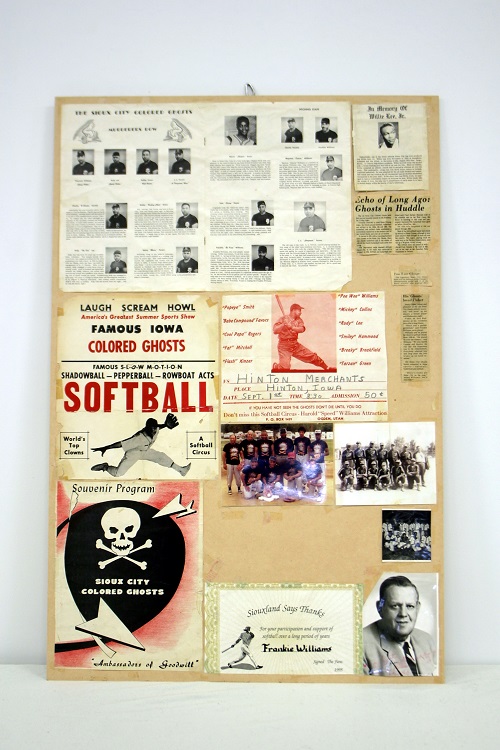 Leaving a legacy
Leaving a legacy
The Ghosts included a variety of beloved players through the years, including Richard “Sitting Bull” Fields, “Oatie” Fields, Riley Fields, Willie Lee, Glenn Smith, Lawrence Freeman, Floyd “Fuji” Fulton, Benny Hamilton, Jamie Hicks, Clarence “Darby” Hicks, Rudy Lee, Major Ray, Fred Tolson, Robert Green, Vivian Johnson, Clayton Johnson, Bob Metcalf, Sam Davis, J.C. “Cool Papa” Johnson, Valse “Mickey Mouse” Metcalf, George “Smokey Joe” Murphy, Harold “Speedy” Williams, Reginald “Cricket” Williams, Frank “Papa Be Kind” Williams, Sam Hays, Benny Hamilton, Les “Spook” Wilkinson and L.J. “Bambino” Favors.
“Favors was quite the ball player,” Aguirre said. “He joined the Ghosts in 1934 and also played for the Colored House of David, Sioux City’s colored baseball team. He was inducted into the Iowa Men’s State Softball Hall of Fame in 1975.”
Favors was mentioned in the article “Colored Ghosts at Lanesboro Saturday,” which ran in the July 12, 1962, issue of the Carroll Daily Times Herald.
“The greatest clown ever to tour with the original Ghosts is L.J. Compound Favors, who played with the first team in 1932 and still catches a few innings in most games,” noted the article, which promoted the “razzle-dazzle softball spectacular” slated for July 14 at 8:30 p.m. against the Lanesboro Merchants. “Favors, an ageless receiver, has shenanigans galore in his bag of tricks to confound both the opposition and the umpires. In addition, he keeps up a constant stream of chatter, which has the stands in a virtual uproar.”
While Favors and his teammates thrilled audiences into the early 1960s in small Iowa towns like Lanesboro, Lake Park, Hinton and other communities, times were changing. One big milestone came in 1947, when Jackie Robinson broke the color barrier by becoming the first black athlete to play Major League Baseball (MLB) after joining the Brooklyn Dodgers.
With the integration of MLB, all-black teams like the Sioux City Ghosts became less common. While the last Sioux City Ghosts player, Franklin Williams, died in 2007, the team’s legacy lives on, thanks to the Sioux City Museum and the Smithsonian Institution in Washington, D.C., which preserves some of the Sioux City Ghosts’ memorabilia.
“The Ghosts helped put Sioux City on the map and acted as ambassadors of Iowa across the nation and internationally,” Aguirre said.
Want more?
I invite you to read more of my blog posts if you value intriguing Iowa stories and history, along with Iowa food, agriculture updates, recipes and tips to make you a better communicator.
If you’re hungry for more stories of Iowa history, check out my top-selling “Culinary History of Iowa: Sweet Corn, Pork Tenderloins, Maid-Rites and More” book from The History Press. Also take a look at my other books, including “Iowa Agriculture: A History of Farming, Family and Food” from The History Press, “Dallas County” and “Calhoun County” book from Arcadia Publishing. All are filled with vintage photos and compelling stories that showcase the history of small-town and rural Iowa. Click here to order your signed copies today! Iowa postcards are available in my online store, too.
If you like what you see and want to be notified when I post new stories, be sure to click on the “subscribe to blog updates/newsletter” button at the top of this page, or click here. Feel free to share this with friends and colleagues who might be interested, too.
Also, if you or someone you know could use my writing services (I’m not only Iowa’s storyteller, but a professionally-trained journalist with 20 years of experience), let’s talk. I work with businesses and organizations within Iowa and across the country to unleash the power of great storytelling to define their brand and connect with their audience through clear, compelling blog posts, articles, news releases, feature stories, newsletter articles, social media, video scripts, and photography. Learn more at www.darcymaulsby.com, or e-mail me at yettergirl@yahoo.com.
Let’s stay in touch. I’m at darcy@darcymaulsby.com, and yettergirl@yahoo.com.
Talk to you soon!
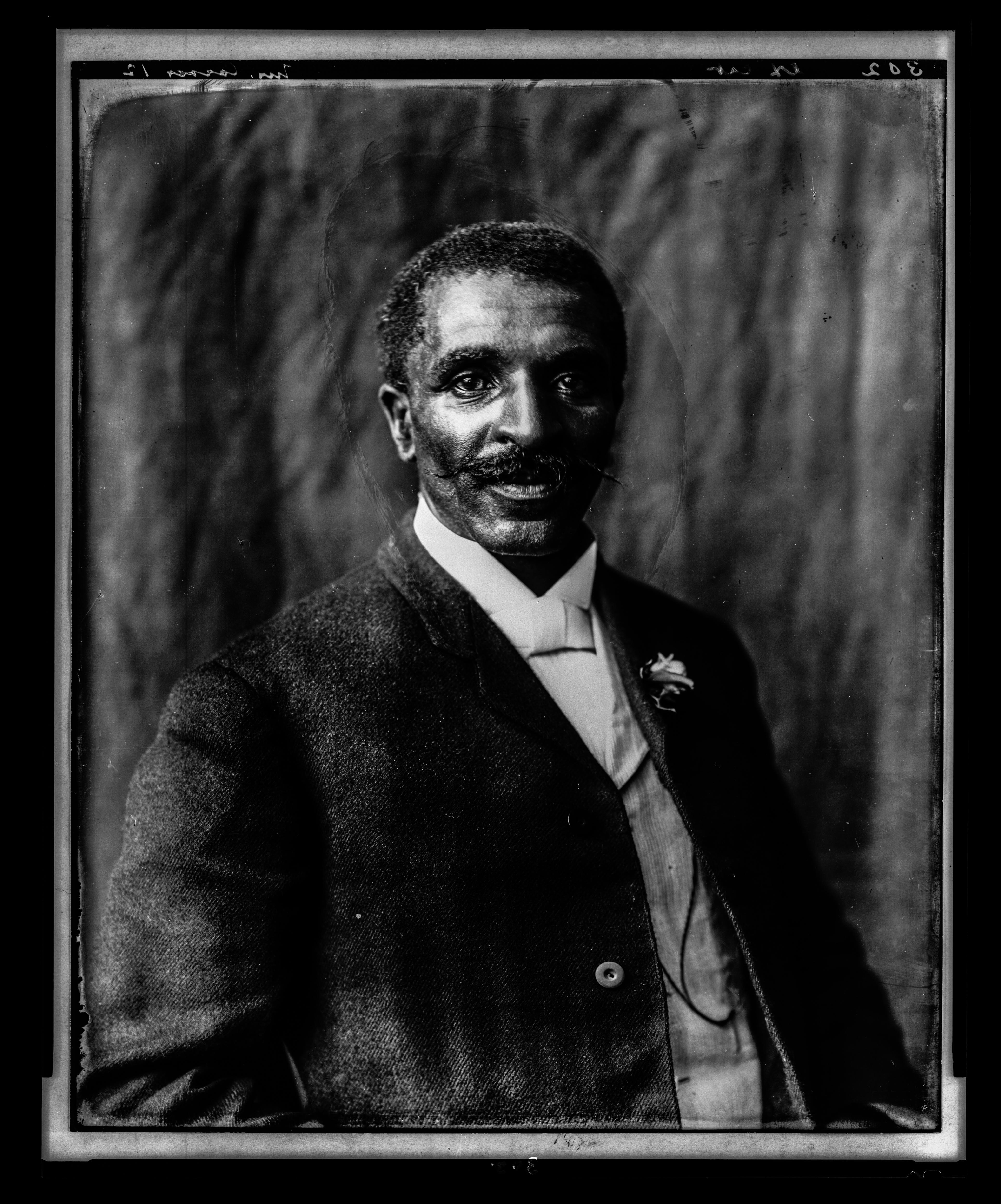
George Washington Carver Rose from Slavery to Ag Scientist
A man who was born a slave changed the world with his agricultural innovations, and the seeds for these contributions were planted in Iowa. When George Washington Carver was a student and faculty member at Iowa State, his research forever changed how farmers look at crop production.
While more than 120 years have passed since Carver completed his bachelor’s and master’s degrees at Iowa State in Ames, his spirit lives on.
Carver’s journey began on a southwest Missouri farm owned by Moses and Susan Carver near the town of Diamond. It’s uncertain whether Carver was born in 1864 or 1865. Both of his parents had been enslaved. His father died around the time of his birth. His mother, Mary, was given her freedom by the Carvers, and she adopted their last name.
The Carvers eventually took young George into their home and raised him as their own. He was unusually talented at almost everything he tried. By the time he was a teenager, Carver left the farm to attend a school for black children in Neosho, Missouri. For the next 10 years, Carver wandered from town to town in Missouri and Kansas in search of a better education. He supported himself by taking in laundry and doing household chores, according to. Iowa Pathways, an online learning environment from Iowa PBS.
“From a child, I had an inordinate desire for knowledge and especially music, painting, flowers, and the sciences, algebra being one of my favorite studies,” Carver wrote. “I wanted to know the name of every stone and flower and insect and bird and beast. I wanted to know where it got its color, where it got its life—but there was no one to tell me.”
Finding a new future, from Winterset to Ames
Carver was accepted at Highland College in Kansas, only to be turned away shortly after he arrived by school officials who were surprised by his skin color. Undeterred, he set off for Iowa, where he arrived in Winterset in 1888. This county seat town in Madison County was located along a section of the Underground Railroad that had been a hotbed of activity from 1857 through 1862, according to the Madison County Historic Preservation Commission.
While Carver found work as a hotel cook in Winterset, he wanted to be an artist—a painter—and capture the beauty of nature that so fascinated him. Friends in Winterset recognized his talents and encouraged him to enroll at Simpson College in Indianola, where he studied art and music. It took only a few months for his art teacher, Etta Budd, to realize that she had nothing else to teach the talented young man. At her urging, Carver transferred in 1891 to Iowa State College in Ames, where her father was the head of the Department of Horticulture.
Through quiet determination and perseverance, Carver excelled at his studies and became involved in all facets of campus life in Ames. He was an active participant in debating and agricultural societies and the Young Men’s Christian Association (YMCA). He was also a trainer for athletic teams (including Iowa State’s football team), captain of the campus military regiment and a dining room employee, according to Iowa State University (ISU). His poetry was published in the student newspaper, and his artwork was exhibited at the 1893 World’s Fair in Chicago.
Carver earned his bachelor’s degree in 1894. “Reading about nature is fine, but if a person walks in the woods and listens carefully, he can learn more than what is in books, for they speak with the voice of God,” Carver said. His professor, Dr. Louis Pammel, encouraged him to stay at Iowa State and pursue a graduate degree. Because of his proficiency in plant breeding, Caver was asked to join the faculty. Not only did he become the first black student at the school to earn a master’s degree (in 1896), but he also became Iowa State’s first black faculty member, all while expanding his knowledge and skills and writing professional papers of national acclaim.
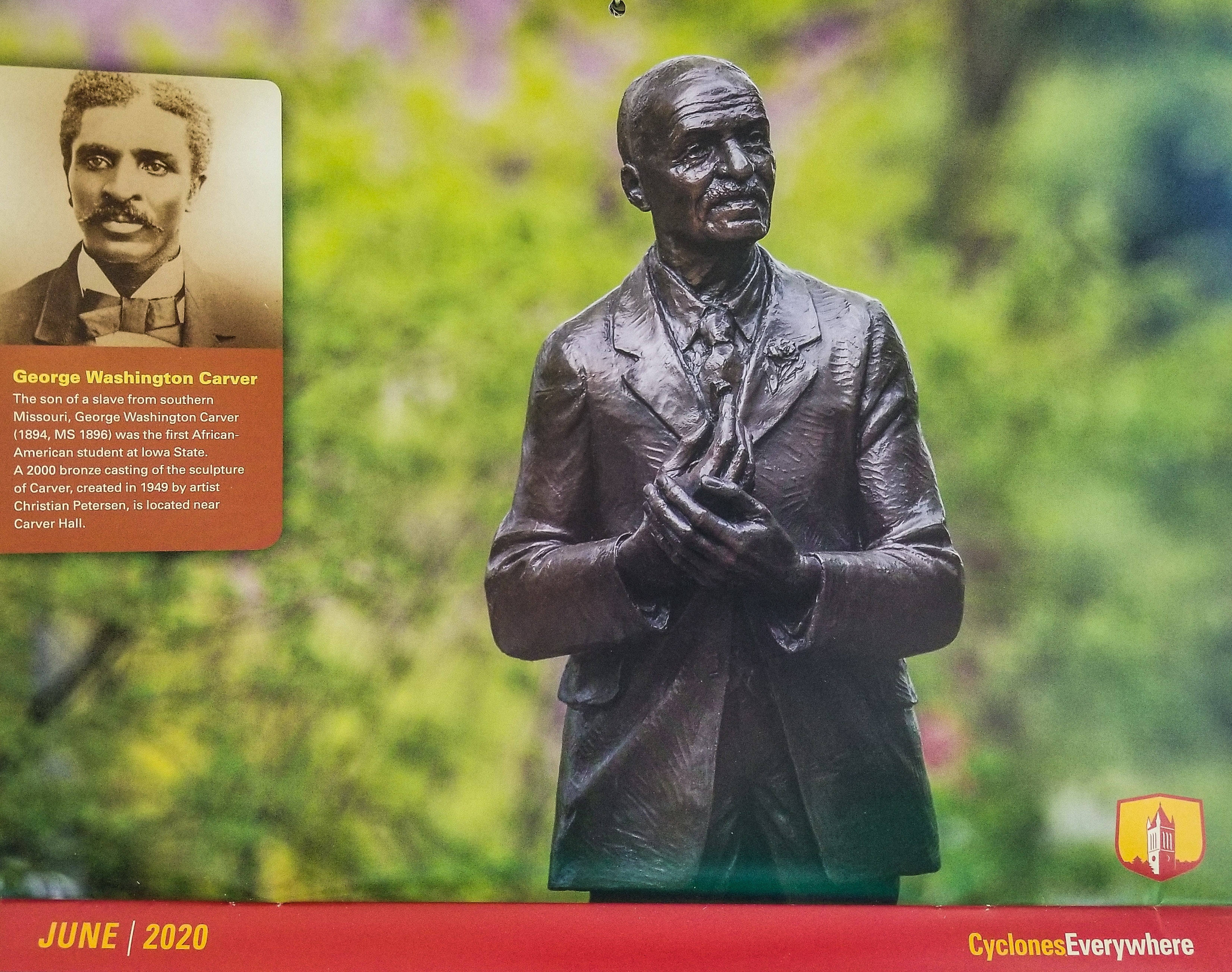
George Washington Carver on Iowa State University calendar
More opportunities take root
Carver planned to earn his doctorate at Iowa State, and the school wanted very much to keep him on its faculty. But then a letter arrived in 1896 that changed everything. “I cannot offer you money, position or fame,” it said. “The first two you have. The last, from the place you now occupy, you will no doubt achieve. These things I now ask you to give up. I offer you in their place work—hard, hard work—the task of bringing a people from degradation, poverty and waste to full manhood.” It was signed by Booker T. Washington, the principal of an industrial and teacher training institute for black students in Tuskegee, Alabama.
Washington was determined to make the Tuskegee Institute the leading black educational institution in the South. He wanted to establish an agriculture department. There were 5 million black farmers in the South. Most lived in poverty and ignorance of scientific agriculture. But to establish such a department, Washington knew that he needed a black man with an advanced degree in agriculture. There was only one such man in America: George Washington Carver.
Carver accepted Washington’s offer. This opportunity to serve fit with Carver’s philosophy that “education is the key to unlock the golden door of freedom.” Carver urged southern farmers to rotate crops and use organic fertilizers. He preached the value of planting soil-restoring crops such as peanuts, sweet potatoes and soybeans.
At Tuskegee, Carver gained an international reputation in research, teaching and outreach. His research resulted in the creation of more than 300 products from peanuts, more than 150 uses for sweet potatoes and multiple uses for soybeans. These products contributed to rural economic improvement by offering alternative crops to cotton that were beneficial for the farmers and the land.
“Anything will give up its secrets if you love it enough,” Carver wrote. “Not only have I found that when I talk to the little flower or to the little peanut they will give up their secrets, but I have found that when I silently commune with people, they give up their secrets also—if you love them enough.”
Some of Carver’s most interesting, plant-based innovations included diesel fuel, axle grease, hand cleaner, stains and paints, gasoline, glue, insecticide, linoleum, printer’s ink, plastics, laundry soap, medicines and more.
Service measures success
During World War I, Carver worked with the U.S. Department of Agriculture (USDA) as a consultant on food and nutrition. Carver had risen to fame nationwide by the 1920s and 1930s, thanks to his agricultural pursuits. By the early 1940s, Carver was working with Henry Ford, founder of Ford Motor Company, who supported the production of ethanol as an alternative fuel and showcased a car with a lightweight plastic body made from soybeans.
Carver remained at Tuskegee until his death in 1943. Landmarks across the nation have been named in honor of Carver, including the George Washington Carver Center on the U.S. Department of Agriculture campus in Beltsville, Maryland. In Iowa, Carver’s legacy is celebrated at Iowa State University, where Carver Hall was named in his honor. Through the George Washington Carver (GWC) Scholarship program, the university awards 100 scholarships in the amount of tuition to multicultural, first-year students coming to college directly out of high school.
All these tributes honor Carver, who devoted his life to education, research and community service to help others. “It is not the style of clothes one wears, neither the kind of automobile one drives, nor the amount of money one has in the bank, that counts,” Carver wrote. “These mean nothing. It is simply service that measures success.”
Want more?
This story is an excerpt from my book Iowa Agriculture: A History of Farming, Family and Food. Click here to learn more and order a signed copy here.
I invite you to read more of my blog posts if you value intriguing Iowa stories and history, along with Iowa food, agriculture updates, recipes and tips to make you a better communicator.
If you’re hungry for more stories of Iowa history, check out my top-selling “Culinary History of Iowa: Sweet Corn, Pork Tenderloins, Maid-Rites and More” book from The History Press. Also take a look at my other books, including “Iowa Agriculture: A History of Farming, Family and Food” from The History Press, “Dallas County” and “Calhoun County” book from Arcadia Publishing. All are filled with vintage photos and compelling stories that showcase the history of small-town and rural Iowa. Click here to order your signed copies today! Iowa postcards are available in my online store, too.
If you like what you see and want to be notified when I post new stories, be sure to click on the “subscribe to blog updates/newsletter” button at the top of this page, or click here. Feel free to share this with friends and colleagues who might be interested, too.
Also, if you or someone you know could use my writing services (I’m not only Iowa’s storyteller, but a professionally-trained journalist with 20 years of experience), let’s talk. I work with businesses and organizations within Iowa and across the country to unleash the power of great storytelling to define their brand and connect with their audience through clear, compelling blog posts, articles, news releases, feature stories, newsletter articles, social media, video scripts, and photography. Learn more at www.darcymaulsby.com, or e-mail me at yettergirl@yahoo.com.
Let’s stay in touch. I’m at darcy@darcymaulsby.com, and yettergirl@yahoo.com.
Talk to you soon!
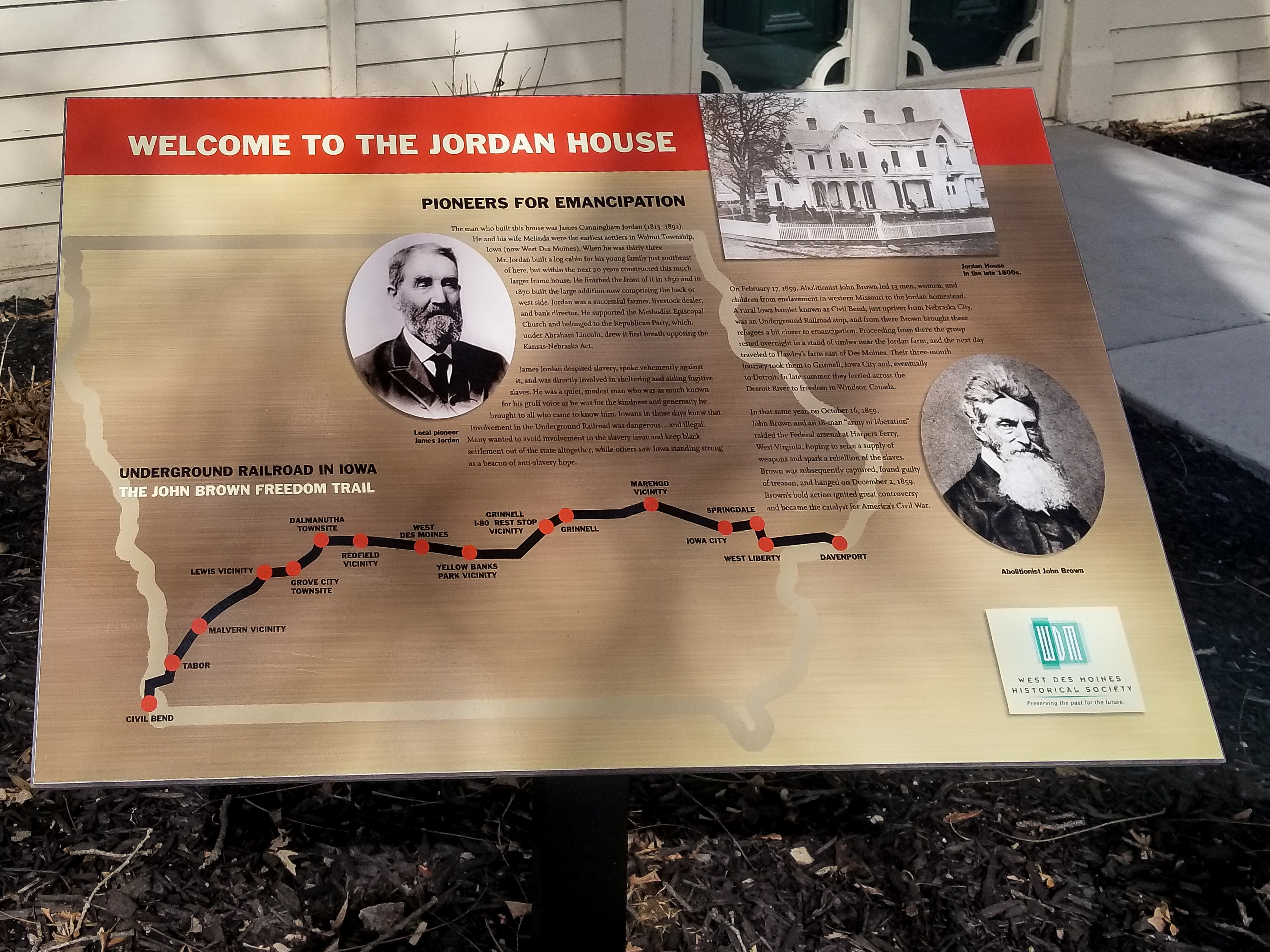
Meet Iowa Farmer James Jordan, Underground Railroad Conductor
Some call them upstanders. Others call them allies. These courageous people are the ones who stand up to help those being oppressed, even at the risk of their own safety. In frontier Iowa, James Jordan fearlessly helped Freedom Seekers gain safe passage on the Underground Railroad route that passed near his farm in the area that would become West Des Moines.
The Underground Railroad ran across the southern and central regions of Iowa, a state where slave ownership was never legal. This impacted pioneer farmer J Jordan (1813-1891) and his wife, Melinda, some of the earliest settlers in Polk County’s Walnut Township. The land they once owned includes the stately Jordan House, which is located along Fuller Road in West Des Moines. The Jordan’s farm harbored fugitive slaves during the tense days leading up to America’s Civil War. Such daring deeds, however, weren’t always part of the Jordan family’s history.
Jordan was born in in 1813 in what is now West Virginia, in a community where slavery was ingrained in society and culture. Jordan, a cattle farmer, was expected to assist family members and neighbors in their hunt for escaped slaves. Jordan’s branch of the family, however, was influenced by a religious movement called “The Great Awakening” that was sweeping the country and opposed slavery. These experiences developed Jordan’s abolitionist beliefs and zeal, especially as he moved westward.

Jordan House, West Des Moines
Building a new life in central Iowa
As treaties were signed between the U.S. government and the Indian tribes that agreed to move out of the Iowa territory by the mid-1840s, pioneers like Jordan were ready to move in. After Jordan settled in the Walnut Township area of Polk County, he chose a beautiful location with ancient oak, walnut and hickory trees on land gently sloping to the Raccoon River. Jordan’s first shelter was a lean-to tent, which he replaced in 1848 with a log cabin.
In 1850, Jordan and his wife, Melinda, began work on the first phase of a new frame house. The family, which at that time included six children, lived for a time in the basement, which included a small kitchen and a bedroom/sitting room.
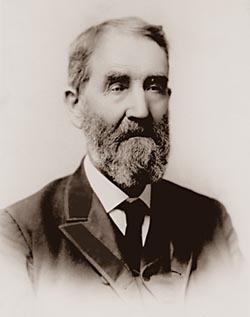
James Jordan
Aiding the Meskwaki
Jordan became a successful farmer, livestock dealer and bank director. Though Jordan’s dream was to develop and manage a financially successful livestock business, he remained deeply committed to helping others achieve their dreams, as well. He supported the Methodist Episcopal Church and belonged to the new Republican Party, which included many members who opposed the Kansas-Nebraska Act that Congress passed in 1854.
The Kansas-Nebraska Act allowed people in the territories of Kansas and Nebraska to decide for themselves whether or not to allow slavery within their borders. The Act repealed the Missouri Compromise of 1820, which prohibited slavery north of latitude 36°30´. The Kansas-Nebraska Act infuriated many in the North, who considered the Missouri Compromise to be a long-standing, binding agreement. There was strong support for the Kansas-Nebraska Act, however, in the pro-slavery South.
Pro-slavery and anti-slavery supporters rushed in to settle Kansas and impact the outcome of the first election held there after the law went into effect. Violence soon erupted, with the anti-slavery forces led by the radical abolitionist John Brown. The territory earned the nickname “bleeding Kansas” as the death toll rose.
Back in Iowa, many citizens wanted to avoid involvement in the slavery issue and keep black settlement out of the state altogether, while others saw Iowa standing strong as a beacon of anti-slavery hope. When Jordan was elected to the Iowa Senate in the mid-1850s, he was able to make a difference Sen. Jordan and his colleagues in the Iowa State Legislature helped the Meskwaki Indians achieve their dream of regaining the land they had lost in Iowa.
Speaking out against slavery
While Jordan was described as a quiet, modest man who was widely-known for the kindness and generosity he showed to all who came to know him, he despised slavery and spoke out vehemently against it. Jordan was actively engaged in the abolitionist movement locally, becoming the “chief conductor” of the Underground Railroad in Polk County. Jordan knew that involvement in the Underground Railroad was dangerous and illegal. Nevertheless, he became directly involved in sheltering and aiding fugitive slaves from his Walnut Township farm.
At the state level, Jordan promoted the anti-slavery Republican Party, and on the national level he befriended the radical abolitionist John Brown. Brown stayed at the Jordan House at least twice, the last time in 1859 when he was leading a group of 12 slaves he had recently liberated in Missouri to freedom in Canada.
On February 17, 1859, Brown led 13 men, women and children who had been enslaved in western Missouri to the Jordan homestead. The small group had begun their journey at a rural Iowa hamlet known as Civil Bend, an Underground Railroad stop just upriver from Nebraska City, Nebraska. From there, Brown brought the refugees a bit closer to emancipation. As they neared central Iowa, the group rested in a stand of timber near the Jordan farm.
(While people on the Underground Railroad stopped at the Jordan family’s property, they most likely never set foot in the actual home. Jordan was one of the largest land owners in the state, plus there were barns and outbuildings on his property, so it didn’t make much sense for freedom seekers to hide in the basement of the Jordan family’s home, according to the West Des Moines Historical Society in a 2018 interview with Des Moines TV station WHO Channel 13.)
After leaving the Jordan farm, the group of freedom seekers traveled the next day to a place called Hawley’s farm east of Des Moines. Their three-month journey took to them to Grinnell, Iowa City and eventually to Detroit, Michigan. In the late summer of 1859, the group ferried across the Detroit River to freedom in Windsor, Canada.
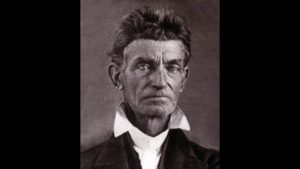
John Brown
Just a few months later, on October 16, 1859, John Brown and an 18-man “army of liberation” raided the federal arsenal at Harpers Ferry, West Virginia, hoping to seize a supply of weapons and spark a rebellion of slaves. Brown was subsequently captured, found guilty of treason, and hanged on December 2, 1859.
It’s interesting to note that Brown’s connections to James Jordan weren’t his only ties to rural Iowa settlers. One line of the Underground Railroad crossed the Raccoon River in southern Dallas County. Fugitive slaves in the 1850s sometimes traveled this route to the “Quaker Divide” northeast of Dexter. Many local members of the Society of Friends (Quakers) supported anti-slavery efforts.
Some residents, like Harmon Cook, were conductors on the Underground Railroad. When Brown was in the Dexter-Redfield area before his 1859 raid on Harper’s Ferry, he admonished Cook after the conductor almost got caught going to Des Moines with fugitive slaves. “Young man, never do so rash a thing as to talk and laugh out loud on the way.”
While no one knows for sure how many slaves reached freedom on the Underground Railroad, historians estimate that 1,000 slaves per year made the attempt. Most who tried did not have the benefit of someone like John Brown or Harriet Tubman to guide them along the journey and were not successful.
Seeking the north star of freedom
Jordan’s role in the Underground Railroad has been honored for generations. “The History of Polk County,” published in 1880, stated that “Jordan has been a life-long enemy of slavery; his devotion to the political life as a staunch and stalwart Republican is the outgrowth of deep-seated conviction; it is among the pleasant things to remember, that under his protecting roof John Brown and his associates, with more than a score of recently liberated slaves, have offered their prayers and sung their first jubilee hymns on their way to Canada….”
Jordan passed away in 1891, but his story lives on. Today, the Jordan House, a stately Victorian home of Italianate Gothic design, is one of the oldest structures in Polk Country and is one of the few locations in Iowa where visitors can tour the home of an Underground Railroad conductor. The home is listed on the National Register of Historic Places and is part of the National Underground Railroad Network to Freedom Program.
Perhaps Jordan’s legacy was best summarized by Jordan’s pastor, who eulogized him by stating, “In the days of slavery this great heart reached out and helped the oppressed, seeking the north star of freedom.”
Click here to learn more if you’d like to plan a visit the Jordan House in West Des Moines.
Want more?
This story is an excerpt from my book Iowa Agriculture: A History of Farming, Family and Food. Click here to learn more and order a signed copy here.
I invite you to read more of my blog posts if you value intriguing Iowa stories and history, along with Iowa food, agriculture updates, recipes and tips to make you a better communicator.
If you’re hungry for more stories of Iowa history, check out my top-selling “Culinary History of Iowa: Sweet Corn, Pork Tenderloins, Maid-Rites and More” book from The History Press. Also take a look at my other books, including “Iowa Agriculture: A History of Farming, Family and Food” from The History Press, “Dallas County” and “Calhoun County” book from Arcadia Publishing. All are filled with vintage photos and compelling stories that showcase the history of small-town and rural Iowa. Click here to order your signed copies today! Iowa postcards are available in my online store, too.
If you like what you see and want to be notified when I post new stories, be sure to click on the “subscribe to blog updates/newsletter” button at the top of this page, or click here. Feel free to share this with friends and colleagues who might be interested, too.
Also, if you or someone you know could use my writing services (I’m not only Iowa’s storyteller, but a professionally-trained journalist with 20 years of experience), let’s talk. I work with businesses and organizations within Iowa and across the country to unleash the power of great storytelling to define their brand and connect with their audience through clear, compelling blog posts, articles, news releases, feature stories, newsletter articles, social media, video scripts, and photography. Learn more at www.darcymaulsby.com, or e-mail me at yettergirl@yahoo.com.
Let’s stay in touch. I’m at darcy@darcymaulsby.com, and yettergirl@yahoo.com.
Talk to you soon!
Darcy

Shattering Silence: Farmer Helped Slave Find Freedom and Racial Equality in Iowa
How much is your freedom worth? In 1834, it was worth $550 for a slave named Ralph Montgomery, whose tumultuous story would involve hope for freedom, dashed dreams, bounty hunters, tremendous risk and a groundbreaking court decision that continues to inspire Iowans to shatter the silence on the volatile issue of racial inequality.
“He was born into slavery, a piece of property allowed only to serve others,” noted the article “Iowa Supreme Court’s First Case Freed a Slave,” which ran in 2015 in The Courier newspaper in Waterloo. “Even his name belonged to someone else.”
He came into the world as Rafe Nelson, probably in about 1795. But early on Nelson became Ralph Montgomery, named for his slave master in Virginia. After being taken to Kentucky by his owner and namesake, Ralph was described as “quite a chunk of a field hand” in his 20s. Despite that fact — or perhaps because of it—Ralph Montgomery, the slave master, sold his slave to a brother.
The new owner, William Montgomery, then sold Ralph in 1830 to a son, Jordan Montgomery. Newspaper accounts of the era described Jordan Montgomery as “kind and indulgent.”
Jordan Montgomery subsequently took Ralph to Palmyra, Mo., located northwest of Hannibal, the famed Mississippi River town. Ralph served his owner for about two years in Palmyra, which was roughly 60 miles south of the Iowa border.
“Here [at Palmyra], Ralph met a white man named Ellis Schofield, who had just returned from a trip to the Upper Mississippi region’s lead mining regions. He told such glowing tales of boundless wealth to be acquired there that Ralph became “seized with a burning desire to go and work out his own salvation,” according to the Janesville Gazette in Wisconsin.
Seeking freedom in Iowa
Jordan Montgomery and Ralph worked out a written agreement sometime around 1834 or 1835, where Ralph committed to pay $550, with interest, for his freedom. He traveled northward, “strong of purpose and light of heart,” according to a story in the Janesville Gazette in 1870.
Ralph went to work mining lead in Dubuque in the Iowa Territory. After five years, however, he hadn’t been able to repay the debt. The problem was the high cost of living. Ralph apparently struggled simply to pay room and board, according to historian Dorothy Schwieder, author of the book Iowa: The Middle Land.
At the same time, Jordan Montgomery experienced financial difficulties, struggling to repay a $4,000 bank loan. When two men from Virginia offered to return Ralph to his cash-strapped master in Missouri for a fee of $100. Jordan Montgomery wasn’t inclined to write off Ralph as bad debt, so he accepted the bounty hunters’ offer.
Shattered dreams
The Virginians swore an affidavit in front of a justice of the peace that Ralph was a fugitive. Court official ordered the local sheriff to assist the bounty hunters. The group found Ralph at his mineral claim, put him in handcuffs and loaded him onto a wagon.
Alexander Butterworth, variously described as a farmer, businessman, concerned eyewitness and noble-hearted Irishman in the Dubuque area, was plowing a nearby field and saw the kidnapping. Butterworth dashed to Dubuque to notify Thomas Wilson, an associate judge on the newly formed Supreme Court of the Territory of Iowa.
Let’s take it to court
Judge Wilson ordered the sheriff to follow the bounty hunters who had seized Ralph and return bring Ralph to Dubuque. Armed with a writ of habeas corpus and accompanied by the sheriff, Butterworth galloped to the rescue, noted historical accounts.
The Virginians had managed to get Ralph to Bellevue, Iowa, along the Mississippi River to board a riverboat that would transport him back to Missouri. Butterworth and the sheriff reached the dock just in time. They ordered the riverboat captain to return Ralph to Dubuque for a hearing before Judge Wilson.
Ralph’s case would turn out to be the first decided by the Territory of Iowa’s Supreme Court, which had been established in 1838 in Burlington. The court’s inaugural case was titled “In the matter if Ralph (a colored man), on Habeas Corpus.”
The legal question was whether Jordan Montgomery had a legitimate claim to demand Ralph’s return. Jordan Montgomery’s lawyers argued when Ralph relocated to the Iowa Territory, slavery was not specifically prohibited in Iowa under the so-called Missouri Compromise of 1820, since a local legislature had not taken additional action to ban it. Jordan Montgomery’s lawyers also claimed Ralph was a fugitive slave, since he had failed to fulfill his contract and should be returned to Missouri under conditions of the federal Fugitive Slave Act.
Ralph Montgomery’s attorney, David Rorer, argued that Ralph became a free man when, by consent of his master, Ralph moved to Iowa. Rorer, and rising star in the Iowa Territory, claimed that his client was neither a slave nor a fugitive, in part because he entered a contract “which presupposes a state of freedom.” Rorer also cited an English case in which it was ruled that a slave having lived in a free country could not be taken to another land that would again lead him into slavery. According to Rorer, the only obligation Ralph owed was to raise the $550 for his former owner in Missouri.
Rorer also cited Chapter 23 of the Book of Deuteronomy in the Bible, which says, in part: “Thou shalt not deliver unto his master the servant which is escaped from his master unto thee: He shall dwell with thee, even among you.”
Ruling delivered on Independence Day 1839
The Iowa Supreme Court conceded Ralph Montgomery should repay Jordan Montgomery — with one key stipulation. “It is a debt which he ought to pay, but for the non-payment of which no man in this territory can be reduced to slavery,” wrote Charles Mason, the first chief justice of the Iowa Supreme Court.
Mason concluded Ralph Montgomery “should be discharged from all custody and constraint, and be permitted to go free while he remains under the protection of our laws.” The Iowa Supreme Court declared Ralph Montgomery a free man on Independence Day, July 4, 1839.
In their opinion, the court justices wrote, “When, in seeking to accomplish his object, (the claimant) illegally restrains a human being of his liberty, it is proper that the laws, which should extend equal protection to men of all colors and conditions, should” intervene.
The unanimous ruling established the tradition in Iowa’s courts of ensuring the rights and liberties of all the people of the state. Years later, the state legislature adopted Iowa’s motto: “Our liberties we prize and our rights we will maintain,” which stands as a permanent reminder that the freedoms in this state are freedoms for all.

What happened to Ralph?
Ralph Montgomery remained in Iowa for the rest of his life. According to the State Historical Society of Iowa, he showed up one day to work in Judge Wilson’s garden in 1840 (one year after the Iowa Supreme Court ruling in his favor). “I ain’t paying you for what you done for me,” Ralph said. “But I want to work for you one day every spring to show you that I never forget.”
Ralph Montgomery stayed in Dubuque the rest of his life, a free man. While not much is known about how he lived the remainder of his life, we do know he continued to mine lead and was a familiar figure around town. While the Dubuque Times in 1870 credited Ralph Montgomery with finding several valuable lodes, he eventually fell in hard times, either through being swindled or by gambling, according to conflicting accounts. During his later years, he lived in the county poor house, according to the Dubuque Times. He succumbed to smallpox, a disease he contracted while nursing a sick patient, during his time in Dubuque’s pest house. He died on July 23, 1870.
(A pest house, short for pestilence house, was a quarantine facility typically found throughout American communities in the late 1800s. Before the development of hospitals, people afflicted with communicable diseases such as tuberculosis, cholera, smallpox or typhus were placed in pest houses.)
Ralph was buried in the city cemetery which became in Jackson Park in later years, according to Encyclopedia Dubuque. When that cemetery was closed, Ralph’s remains were among those moved to Linwood Cemetery, where they were buried in a mass grave.
Ralph Montgomery’s case offered much different outcome than Dred Scott case
Eighteen years later, the lessons of Ralph Montgomery’s case seemed to be forgotten when Missouri slave Dred Scott pleaded his case for freedom in court. On March 6, 1857, the U.S. Supreme Court handed down its decision on Sanford v. Dred Scott, a case that intensified national divisions over the issue of slavery.
In 1834, Dred Scott, a slave, had been taken to Illinois, a free state, and then to the Wisconsin Territory, an area where the Missouri Compromise of 1820 prohibited slavery. Scott lived in Wisconsin with his master, Dr. John Emerson, for several years before returning to Missouri, a slave state. In 1846, after Emerson died, Scott sued his master’s widow for his freedom on the grounds that he had lived as a resident of a free state and territory. He won his suit in a lower court, but the Missouri Supreme Court reversed the decision.
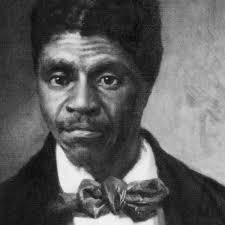
Dred Scott
Scott appealed the decision. A federal court decided to hear the case on the basis of the diversity of state citizenship represented. After a federal district court decided against Scott, the case came on appeal to the U.S. Supreme Court, which was divided along slavery and antislavery lines; although the Southern justices had a majority.
During the trial, the antislavery justices used the case to defend the constitutionality of the Missouri Compromise, which had been repealed by the Kansas-Nebraska Act of 1854. The Southern majority responded by ruling on March 6, 1857, that the Missouri Compromise was unconstitutional and that Congress had no power to prohibit slavery in the territories. Three of the Southern justices also held that African Americans who were slaves or whose ancestors were slaves were not entitled to the rights of a federal citizen, and therefore had no standing in court.
These rulings all confirmed that, in the view of the nation’s highest court, under no condition did Dred Scott have the legal right to request his freedom. The Supreme Court’s verdict further inflamed the irrepressible differences in America over the issue of slavery, which in 1861 erupted with the outbreak of the American Civil War.
Shattering Silence
It would take the Civil War, the passage of the 13th Amendment to abolish slavery and the civil rights’ movement of the mid-20th century to help create a more just America for everyone, regardless of race. The battle is not yet over, as evidenced by the Black Lives Matter movement, police brutality (in tragic cases such as the death of George Floyd in Minneapolis in late May 2020) and the resulting civil unrest that has swept America.

Shattering Silence in Des Moines near Iowa Supreme Court (photo from Des Moines Public Art Foundation)
Even as racial-charged protests turned into riots in downtown Des Moines during the weekend of May 30-31, a 30-foot sculpture near the Iowa Supreme Court pointed to the hope that has endured in Iowa from the beginning.
“Shattering Silence,” which features a ring made of limestone quarried in Dubuque, was designed by artist James Ellwanger and installed in 2009 on the 170th anniversary of the Iowa Territory Supreme Court’s landmark decision in the Ralph Montgomery case. (Photo credit for the winter image of Shattering Silence that I used with this post goes to Jason Mrachnia.)
The stunning sculpture stands at the top of the hill overlooking the Des Moines skyline. The Iowa Art Council has called the piece a commemoration of “those moments when Iowa has been at the forefront of breaking the silence of inequality and commemorates those Iowans who refused to stand by silently when they saw injustice.”
Former slave who made history in Iowa leaves powerful legacy
Back in Dubuque, local residents raised money in recent years to install a tombstone to honor Ralph Montgomery. On October 1, 2016, community leaders unveiled a monument to Ralph in the Linwood Cemetery to highlight Iowa’s ongoing role in shattering the silence on the issue of racial inequality.
“We are gathered today to honor a man who has brought such honor to this state by helping us discover not only who we were at that time, but who we would hope to become today,” said Mark Cady, former chief justice of the Iowa Supreme Court who passed away in November 2019. “Ralph Montgomery suffered through the indignity of slavery to rise and stand against it and help forge a great meaning …of our collective belief in equality, both then and now.”
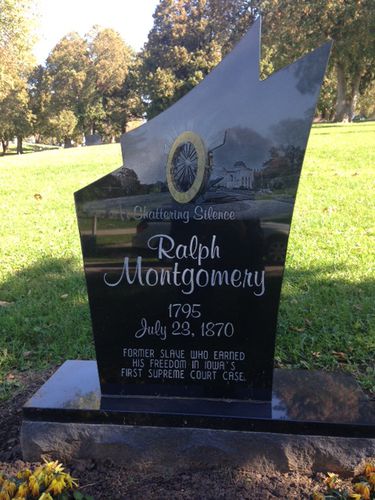
Want more?
I invite you to read more of my blog posts if you value intriguing Iowa stories and history, along with Iowa food, agriculture updates, recipes and tips to make you a better communicator.
If you’re hungry for more stories of Iowa history, check out my top-selling “Culinary History of Iowa: Sweet Corn, Pork Tenderloins, Maid-Rites and More” book from The History Press. Also take a look at my other books, including “Iowa Agriculture: A History of Farming, Family and Food” from The History Press, “Dallas County” and “Calhoun County” book from Arcadia Publishing. All are filled with vintage photos and compelling stories that showcase the history of small-town and rural Iowa. Click here to order your signed copies today! Iowa postcards are available in my online store, too.
If you like what you see and want to be notified when I post new stories, be sure to click on the “subscribe to blog updates/newsletter” button at the top of this page, or click here. Feel free to share this with friends and colleagues who might be interested, too.
Also, if you or someone you know could use my writing services (I’m not only Iowa’s storyteller, but a professionally-trained journalist with 20 years of experience), let’s talk. I work with businesses and organizations within Iowa and across the country to unleash the power of great storytelling to define their brand and connect with their audience through clear, compelling blog posts, articles, news releases, feature stories, newsletter articles, social media, video scripts, and photography. Learn more at www.darcymaulsby.com, or e-mail me at yettergirl@yahoo.com.
Let’s stay in touch. I’m at darcy@darcymaulsby.com, and yettergirl@yahoo.com.
Talk to you soon!



